#we need to accept that aging is a natural process and that we cannot reverse it. aging is beautiful because it means we have lived
Explore tagged Tumblr posts
Text
What If S1E4 Meta: The True “Heart”
The same way Stephen couldn’t let go of Christine in the fourth installment of What If...?, I haven’t been able to shake this episode off and out of my head since watching it. I’m pretty sure it’s put me through the grieving process. Lately, it’s been haunting me like a ghost, and while mentally revisiting it for the fourteen millionth time, I realized something BRUTAL that I just had to share ASAP!
Hear me out, homies. What if...
The running theme and title of the episode was Stephen Strange losing his “heart.” But although the setup and storyline seems to suggest the euphemism refers to Christine Palmer, it doesn’t! The “heart” of Stephen Strange is not the girl of his dreams he lost in that car accident, but the greater man he had gained.
OK LISTEN. Let me have a shot to show you what I see (even in shite quality, pardon my crappy screenshots). Let’s start with the DS1 recap, 'cuz I’m still not over the first movie, either, and it’s relevant.
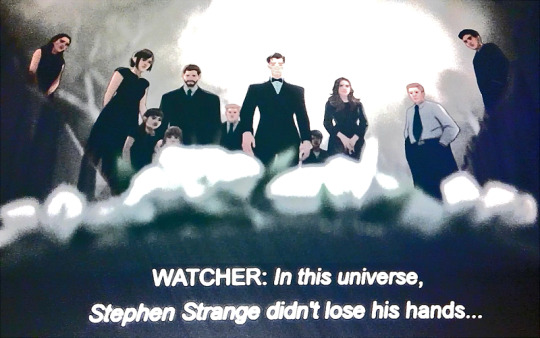

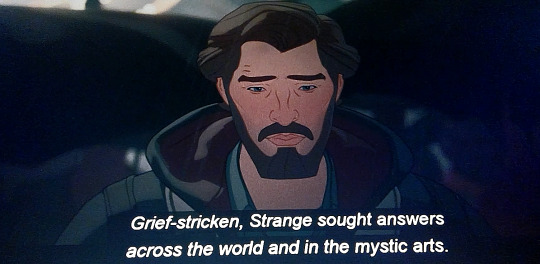
Like the watcher explained, after the devastating and tragic death of the love of his life, Stephen Strange began to look for answers. Not different from Stephen Strange of the sacred timeline, he was obsessed with reversing the great loss and trauma he’d endured. It was with the same perfectionism that made him a great surgeon, that Stephen sought the power to “find his own way back.”
... By any means necessary.
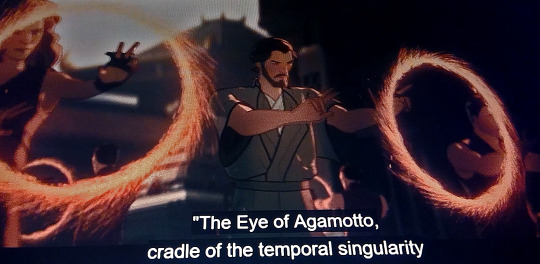
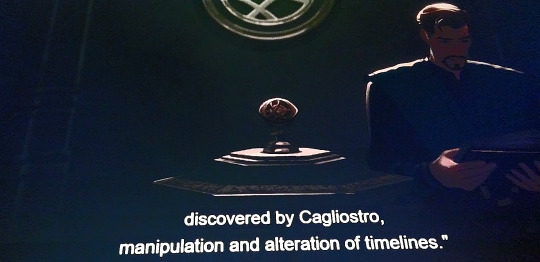
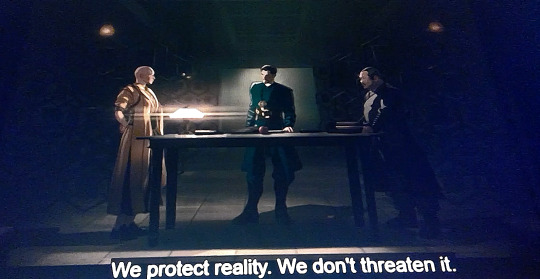
They both discover that “power” they were searching for when they stumble upon time magic. However, Stephen is lectured that time magic is something that could risk the stability of the universe, and should never be done lightly and certainly never for the sake of one person over all others. Although harm is not his nature and Stephen doesn’t want to hurt anyone, he struggles to give up on his quest to heal his hands, or alternatively, to resurrect Christine. He was told a solution wasn’t out there, but found it in the Book of Cagliostro.
Despite every person that told him it couldn’t be done, Stephen can’t accept that. He won’t admit there’s nothing that can be done, there has to be something he can do. He’s conceited with the delusion he can alter his past to better his present. And he won’t be swayed of it.
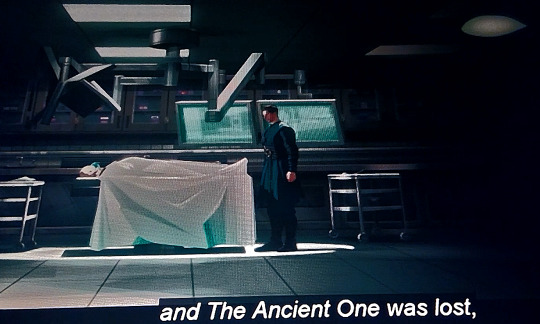

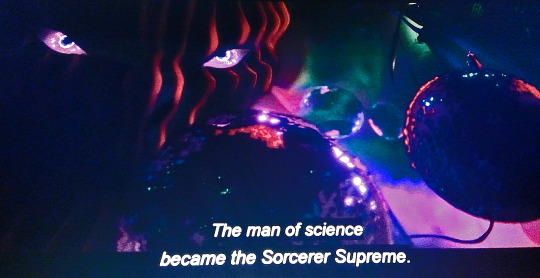
But when the Ancient One fell, Stephen Strange rose to take her place and fend against the invading Dormammu. He saw for the first time the world that was so much bigger than him, that he could do so much good for, more than good only for himself. He saw the millions of lives that had not yet been lost to tragedy he could prevent and save from it, even if not what hardships had already been done and could not be undone in his own life. Things he could save, not fix.
And it wasn’t his own life he saved with that time magic in the end, but earth itself. And Stephen Strange became something much bigger than himself. No matter what he’d lost in that car accident, he learned there was still much more he could gain, regardless of what he’d lost. He didn’t need to fix his hands. They were still good.
Better than his brilliant mind, was his beautiful heart.
His capacity for goodness, not greatness.
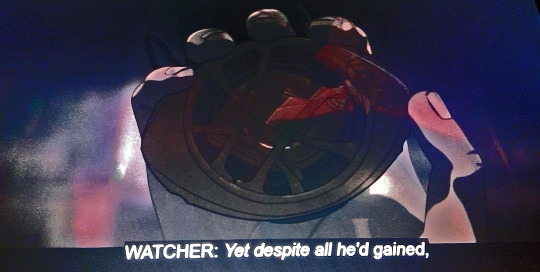
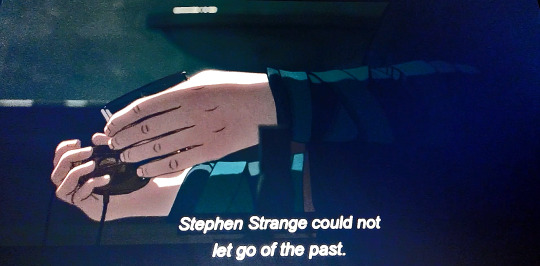
And yet, for all the good he’d achieved and learned, on the two year anniversary of Christine’s death, Stephen can’t help but get sucked into his past, and in a moment of weakness, allow his grief power over him once more. He can’t stop reliving the past. He loops it over and over again, trying to reverse fate, trying to find a way to spare Christine and find that “miracle” that must exist to spare her.
The Ancient One has sensed his presence and meddling with the Eye of Agamotto, and warns Stephen that the path he had set himself on would lead him only to more pain. When Stephen refuses to be reasoned with, the Ancient One brandishes him with a single blow before he escapes into the past. He thinks she missed. She didn’t.
SHOT THROUGH THE HEART, AND YOU’RE TO BLAME! DARLING YOU GIVE LOVE A BAD NAME!
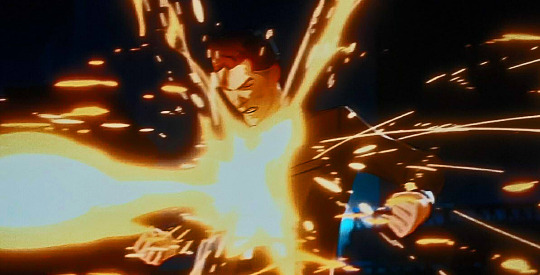
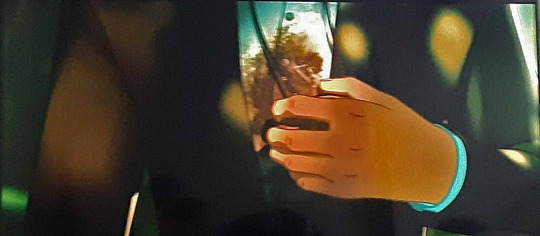
But *ahem* seriously, notice how Stephen was struck mid center his chest, directly over his heart. It was in that moment that Stephen Strange lost his “heart,” as the Ancient One had knocked it out of him, just as she had knocked him out of his own oversized head when they first met. Theory: she cast a spell to separate Stephen’s heart from his mind, the two halves that make one complete man.
Because even if Stephen Strange’s mind was still set on Christine Palmer, his heart had been changed, and there was still hope for it. And Stephen Strange’s heart had enough with “living in the past for one day,” and chose instead to share drinks with Wong.
Meanwhile, Stephen’s “mind” searched the Library of Cagliostro for a way to reverse an absolute point and save Christine. Eventually, he found the answer he was looking for. He needed more power, that could be obtained by otherworldly creatures. Now, harm is not in Stephen’s nature. On his first attempt, he actually tries asking “nicely,” and ends up getting ass kicked.
O’Bengh, the librarian of the books of Cagliostro, patches up his body and tries to warn Stephen. He may have lost his heart, but if he he keeps going at this rate, he was well on his way to losing his mind.
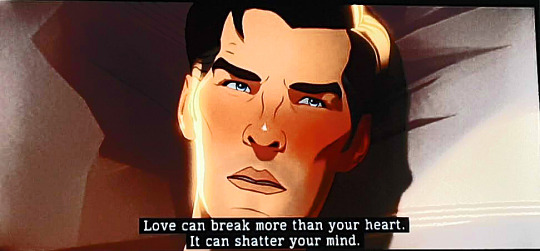
But Stephen didn’t heed those words of warning. He distorted his body, darkened himself with every sacrifice he made for Christine’s sake. So caught up in the memory of Christine’s greatness, Stephen had forgotten he’d once had one of his own. Christine was all he saw.
So obsessed with her, he lost himself.
When Strange returns to O’Bengh’s side, the librarian has aged and is dying. He reveals the passage of centuries Stephen has spent devoted to this madness. As someone Stephen thinks of as a friend passes away, Stephen can’t think to cherish these last moments or listen carefully to his final words. All he can think is to use his magic to spare O’Bengh, which O’Bengh refuses, trying one last time to reach through to Stephen before giving up and leaving hope to the “heart” to be strong enough to withstand and stop him.

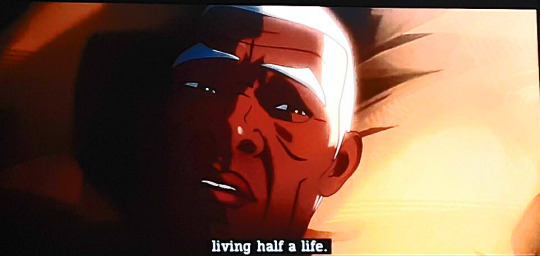
*Wink, wink, wink.* Do you see it now?
Now, onto the confrontation between heart and mind. Stephen’s mind can’t achieve anything if his heart isn’t in it, and I love the symbolism of that. He must get it on board first, unite on both fronts.
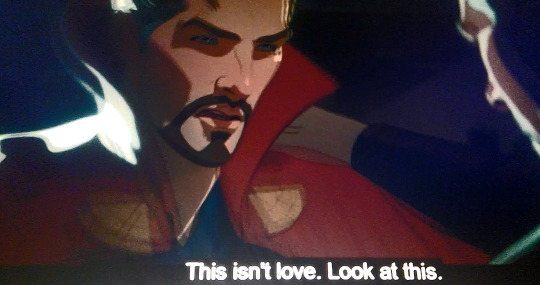
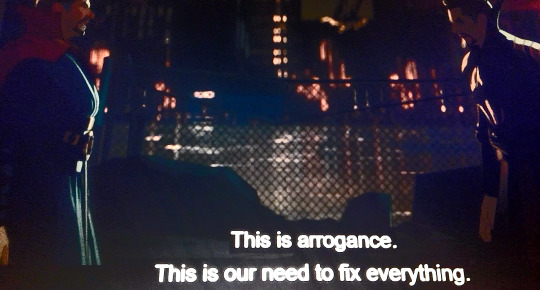
Stephen’s heart can recognize that this isn’t love, but the work of his broken mind lost in a delusion. And Stephen’s so far gone down the rabbit hole, he won’t even listen to his heart. Instead he ignores it, even burns the cloak of levitation... the very symbol of his finding something new that could uplift him after spending so long down on his knees in the past... and he burnt it to ash. When his heart won’t be persuaded, he resorts to trickery, attempting to con his heart with the same delusion that haunts his mind. It’s the same Christine that Stephen first was hung up imagining when he picked up the eye of the Agamotto and got himself into this mess, his trump card.

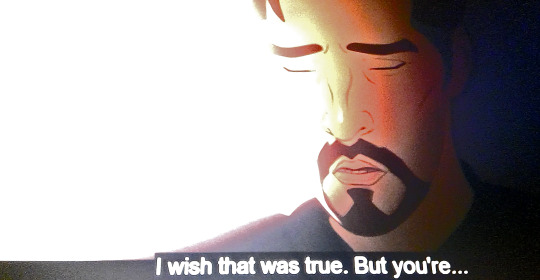
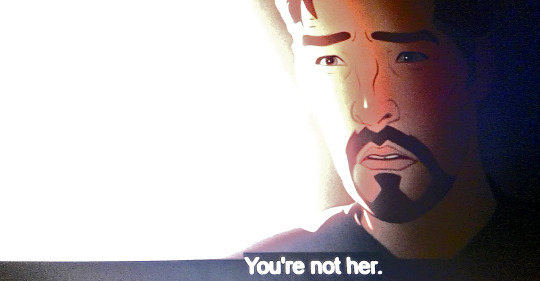
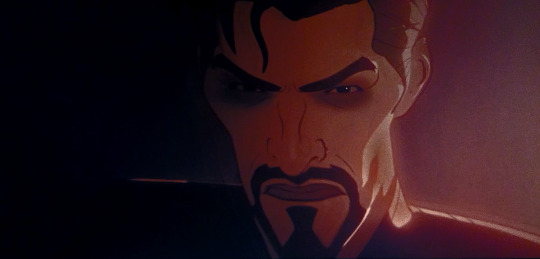
But again, the heart cannot be deceived. It knows Christine is dead, and it realizes the fantasy his mind is pursuing is not the same as the Christine they once knew and loved. More importantly, his heart remembers that there are other people who need him now, people that are not beyond saving. And the mind is done playing.
If his heart won’t come willing, then he’ll just have to beat it into submission until it can’t make a single sound of protest, and then swallow it whole. Stephen makes the ultimate sacrifice the Ancient One had tried so hard to prevent, and abandons that heart she saw so much potential in and inspired her to teach him.
This episode AMAZINGLY tackles the narcissism and arrogance that hides in specific shades of grief and depression. In believing our problems are greater than anyone else’s, that no one else could understand as Stephen insisted “they didn’t know her!” The selfishness that comes with refusing to see the world or those around you that still need you and choosing instead to chase the memory of the ones you’ve already lost, who are beyond saving. If we choose those delusions over our reality, in the end, we will lose everything, and the ones who will pay the price for your arrogance won’t be you, but the ones you loved. Even the memory of the one you loved, that you twisted to fit your mold. There’s a selfishness in seeing only the bad of what was rather than the good of what could come.

Unless you want to end up alone inside a cold and empty shell, maybe it’s time to listen to your heart, and move on.
134 notes
·
View notes
Text
Sanders Sides Headcanons: animal traits and the concept of "darkening"
Anyone who likes Sanders Sides and doesn't live under a rock knows that the Dark Sides possess animal traits and motifs. Let's see:
Janus's animal is the snake. It's quite clear just by looking at him: half of his face is covered in scales, one of his eyes is snake-like, a two-headed snake is his symbol, etc.
Remus's animal is the octopus. This is not as obvious as with Janus, but his symbol features octopus tentacles and his costume has green octopus-like details.
Virgil is the spider. While this hasn't been shown on the show, it's a popular fanon, and there's plenty of fanart of Virgil with spider traits (multiple eyes, spider legs, fangs etc.). Aside from that, spider imagery tends to be seen around Virgil: his room is full of spider webs, he has a (toy) pet spider, his curtains have spiders printed on them, he hisses, etc.
However, recently we've seen that animal traits are not exclusive to Dark Sides: Patton, in a great moment of stress, transformed into a giant frog. While this was just to keep with the running gag of Patton's love for Frogger, it's also the first time we've seen a Light Side explicitly taking animal traits. Nevertheless, we must analyze the context where these traits were revealed.
Which takes us to the concept of "darkening".
To discuss darkening, we must see what exactly is a 'dark' Side.
Dark doesn't mean "evil", or at least not irredeemable evil. All Sides mean well and want to help Thomas or get more recognition. Yes, even trash boi Remus.
What dark means is "counterproductive". Even if they mean well, Dark Sides don't seem to help Thomas; or at least, not in an obvious way.
Janus wants Thomas to take care of himself, and that's a noble endeavor; but he still prefers sabotage and manipulation to being upfront with his intentions and helping straightforwardly, which led to Thomas making bad decisions and being confused by his actions. It was only when Janus was actually honest and worked with the other Sides instead of against them that Thomas finally understood what he was trying to do and the others (sans Roman and Virgil) felt more at ease with him around.
Remus wants Thomas to acknowledge the dark parts of himself and be more risqué with his creative content; but he doesn't understand that the reason Thomas doesn't want to acknowledge the thoughts Remus produces is because they disturb him, and it's not that he doesn't want to delve into more "edgy" stuff, but he'd rather approach them from a more serious and philosophical angle. Thomas (both Sanders Sides Thomas and real life Thomas) doesn't shy away from discussing mental health issues, showing the impact of a religious upbringing in a person's moral code, researching topics like intrusive thoughts and the ambiguity of selfishness, or even showing himself and his friends (and Leslie Odom Jr.) dying in the name of being 'altruistic'. Remus just doesn't understand that, and that probably has to do with the fact Roman took King Creativity's moral compass when the Moral Split happened, resulting in Roman being mindful of people's sensibilities and Remus being completely amoral.
Finally, Virgil, prior to reconciling with Thomas and the Light Sides, only wanted to protect his charge, and still does; but acting antagonistic and scaring all the others so they'd pay attention to him only worked against him: Logan didn't understand him, neither Janus nor Remus took him seriously, and Thomas and Roman resented him for doing his job. Sure, most of the blow came from the others not really appreciating Virgil or making the effort of understanding his actions, but part of it - as he himself admitted - was Virgil acting scary so he would be listened to. The moment Thomas actually understood his function and accepted him just the way he is, Virgil eased up and started to relax around the others, leading his input to be seen as helpful and he himself to try and keep a more friendly stance towards the others.
So, having established that, to Sides, being dark is being counterproductive towards the charge (Thomas), we can say that "darkening" is the process of a Side accidentally or deliberately being unhelpful to the point Thomas is badly hurt, at least from their perspective. Darkening is a corruption or bastardization of a Side's core function caused by incredible stress and confusion: when a Side doesn't know what to do anymore, when everything they do or say is wrong, their own domain of thought turns against them and transforms them into an extreme version of themselves.
Darkening is like a Steven Universe corruption or magical girls witching out: despair, stress and confusion warp a Side's mind until they don't know who they are anymore, and their state of mind is reflected in their physical form.
Which brings us back to animal traits.
Because what happens when Patton finally has enough and refuses to listen to more moral dilemmas?
He gains animal traits, just like 'dark' Sides have. He becomes unhelpful, useless (from his own perspective). Patton darkens in that moment. Darkening is a fall from grace.
You know who else become animal-like when they fall from grace?
Christian demons.
That's right, folks: Remus is not the only one who reflects Thomas's Catholic upbringing. Subconsciously, all Sides are bound by religious beliefs, and these affect them when they're at their lowest. Patton, being the one who received and internalized the Catholic moral code when Thomas was growing up, is the first to show how 'falling from grace' affects a Side's physical form.
When an angel falls and becomes a demon, they gain animal traits to reflect their more violent and primal nature (ignoring the fact many of these demons had actually been Pagan deities before Chistianity took them and turned them into incarnations of evil). This also comes (at least, according to Good Omens, I don't know much of real-life demonology) with a change of name. Fanon gives different names to Light Sides's dark versions: @parano-vigilant-snake-boy, in response to my "King Creativity Rex" theory, called dark! Roman Burnout.
So, in short, when a Side (again, and I cannot stress this enough, from their point of view) fails to live up to Thomas's needs, they fall from his grace. They turn from guardian angels to demons and adopt the traits of such. They darken. Those who never believed themselves to be angels in the first place, like Janus, Remus and Virgil, adopt the traits from the get-go. It must also be noted that the animals that the Sides adopt are regarded as demonic or spooky, such as snakes, octopuses and spiders.
With all this said, what would other Sides' dark forms be if they believed they've fallen from grace?
Patton, as seen, takes on frog traits. Frogs, or rather toads, have been regarded as demonic animals: one of demon king Bael's forms is that of a toad. It probably has to do with their rather unpleasant appearance. There's a post here on Tumblr (I don't remember the author, please tell me if you're it or know who it is) that says that some frogs have heart-shaped pupils, which suits our sweet boi Patton. His name, based on his extreme, insane altruism and to keep with the religious themes, would be something along the lines of Martyrdom.
Logan takes on owl traits. This has been already explored in @parano--vigilant reverse au. The owl is considered an animal of wisdom: one of the goddess Athena's atributes was the owl, and the character of Owl in Winnie the Pooh is supposed to be wise (but kinda falls short). However, the owl has also been considered a demonic animal: Great Prince of Hell Stolas was depicted in the Ars Goetia as a crowned owl with long legs. In the Middle Ages, certain types of knowledge, like medicine and astronomy (the latter of which Logan adores) were forbidden because they were 'demonic' in nature. So, in a certain way, the owl also represents forbidden knowledge, and being a creature of the night only adds to the spookyness. Logan would relate a lot to the owl, given the others often don't want to listen to him or don't like what he says because it's the cold, hard truth. His name would probably be something along the lines of Forbidden or Secret Knowledge, if anything to reflect an attitude of 'I know something that you don't' or 'I could tell you but I don't want to'. His owl imagery might also be related to Thomas's love of Disney and based on the character of Owl.
Roman takes on goat and/or ram traits. Not only are these common traits for demons (including Lucifer himself), but goats also represent the wild, untamed and lustful side of humanity. Fauns and satyrs, for example, were half-goat mythological creatures that spent their time chasing women and accompanying the god of hedonism himself, Dyonisus. Roman is Thomas's passionate and fanciful side who likes to indulge and enjoy the pleasures of life, as well as the most romantic and the most concerned with courting Thomas's crushes. Besides, you need to be pretty extra to give yourself goat and/or ram horns. His name would vary depending on how rejection affects him: he could turn into Wrath or Revenge if he lets his more fiery side take hold, or he could turn into Burnout if he finally gives up and refuses to help Thomas anymore after his charge seemingly betrayed him.
The Orange Side has been headcanonned around as a butterfly. Depending on his nature, this could go two ways: if he's an independent Side, then he would be a moth, keeping up with the spoopy theme; if he turns out to be King Creativity/Rex (please visit the post with my theory of who the orange Side will be), then he would probably be a butterfly, the animal of metamorphosis (reflects how Rex is the fusion of Roman and Remus) and a 'pretty', flashy counterpart to the rather drab moth, reflecting how extra the Creativitwins are and how detached from both the Dark and Light Sides he is (because he's a mix of both, he gets to pick an animal, like a Dark Side, but he gets a non-demonic or spooky one, suited for a non-darkened Light Side).
Hoo wee, that was a long one. This might be just baloney, but please tell me what you think. If you've made it this far, thank you, from the bottom of my heart. I spent a lot of time in this theory.
#sanders sides#sanders sides universe#sanders sides headcanon#janus sanders#remus sanders#virgil sanders#patton sanders#lilypadton#roman sanders#logan sanders#darkening#leslie odom jr#religion discussion#religious imagery#catholicism#christianity#good omens#demonology#martyrdom#forbidden knowledge#secret knowledge#wrath#revenge#burnout#orange side#rex sanders#king creativity#creativitwins#metamorphosis
15 notes
·
View notes
Photo
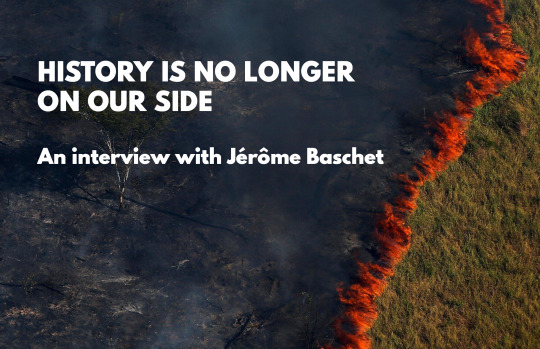
‘HISTORY IS NO LONGER ON OUR SIDE’ - An Interview with Jérôme Baschet (2019)
Interview conducted on September 12, 2019 by ACTA, on the occasion of Baschet’s new book on the Gilets Jaunes uprising, Une Juste colère. Interrompre la destruction du monde.
Translated by Ill Will Editions
***
1. I would like to begin by asking about the title of your book, or rather, its subtitle: “interrupting the destruction of the world.” Since the 19th century, and for quite some time, the tradition of the communist movement has thought of revolution as, in Marx’s words, a "locomotive of history.” In other words, that human emancipation was somehow inscribed in historical development itself. Walter Benjamin reversed this formula, suggesting that revolution would rather be "the act by which humanity aboard the train applies the emergency brake.” You seem to be more in line with this latter filiation. What are the issues at stake for you of such a paradigm shift? And how are they linked in particular to the current ecological disaster? [1]
Jérôme Baschet: I’m quite happy to accept your Benjaminian reading of the subtitle. Let me add something about the term “destruction,” which seems to me to be characteristic of a third age of the critique of capitalism. If the first age focused on exploitation, and the second on alienation, the third now focuses on destruction. Although it was certainly anticipated here and there, this shift in dimension is now clearly becoming dominant, as ecological devastation - in the broad sense of Guattari's three ecologies - now comes to the fore. This does not mean that the other dimensions of critique - and the other aspects of capitalist domination they pointed to - are somehow invalidated; they must simply be reformulated in a new context where capitalist barbarism reaches such a degree that the very possibility of life on Earth is potentially called into question.
"Interrupting the destruction of the world,” then—although I might as well have said, even if the wording may seem strange, "interrupting the world of destruction.” For it is indeed a question of interrupting the course of this world of destruction, which crushes and annihilates so many manifold worlds. To interrupt the destruction of the world, in short, can only mean ending the world of destruction. And this world is the world of the Economy - a world dominated by economic tyranny and animated by a productivist compulsion that is the direct source of the present ecological and human devastation.
This insight implies a "paradigm shift" in our conception of the revolution and, more broadly, of historical time. It has recently been said that there is a major cleavage within the thought of emancipation. For some, it is necessary to preserve, or rediscover, the classical parameters of modernity, and in particular a conception of History understood as a triumphant advance of Progress. It certainly seems increasingly difficult to uphold such an image; yet some persist, in spite of every obstacle, in pushing this line, defending "accelerationist" theses according to which, to exit capitalism, it is necessary not only to continue "in the direction of history,” but even to move as fast as possible by intensifying the most advanced technological and organizational characteristics of capitalism. Full speed ahead, comrades! On the other side of the dividing line are all those who, following Benjamin, consider that we must completely abandon an untenable modern-progressive conception of history. To the arguments that Benjamin put forward in 1940, many others have since been added; and today it is ecological destruction that visibly and dramatically transforms the glorious march of Progress into a mad dash towards the abyss.
All this has important implications for the way in which a possible revolutionary process is conceived, but also, more broadly, for the relationship between present and future, or between past and future. We no longer have History on our side; we are no longer messengers on behalf of any sense of History that would inexorably lead us to salvation. There is a whole swath of representations wrapped up in this that need to be overcome, many of which have been highly effective at the level of organization, even if it is easy these days to recognize their fictitious and illusory nature. But it also means that another vision of history, of collective action, and of the intertwining in the present of the living memory of recollected pasts and the anticipation of possible futures, must be entirely invented.
2. Let's turn now to the Yellow Vest movement, and your book about it. You insist that an essential trait that characterizes the movement lies in its refusal of representation, the refusal to be “recuperated by politicians” and normalized by the classical forms of politics. It is certainly striking to observe that, whereas many if not most of the mass movements of the previous cycle of struggle paved the way for parliamentary parties claiming to embody their "political outlet" (Podemos in Spain, Syriza in Greece) yet producing only renewed forms of social democracy, the Yellow Vests have so far deviated from the rule. How should we explain this? Whence this deeply rooted refusal of political representation and traditional parliamentary games?
The Yellow Vests uprising has blown apart the frameworks of classical politics, based as it is on the principle of representation, whose center of gravity turns around political parties locked into electoral competitions over control of the State apparatus. Of course, we have seen the inverse tendency too, here and there, with people attempting to play the role of spokespersons for the movement, acting as self-proclaimed negotiators with the government. There have been attempts by far-right or left-wing militants to infiltrate and steer the movement. But what has been most impressive is the collective intelligence deployed by the various groups of Yellow Vests, most often successfully, which has detected all of this and prevented the takeover of the movement by political sects or trade union activists. The more militant leftist characters that have been allowed to move among the Yellow Vests have generally only been able to integrate provided they abandon their usual speeches and attitudes and adapt to a collective dynamic that breaks with the parameters of classical politics.
No one can predict what will happen, but it is unlikely that parties such as Podemos will manage to assert themselves in France as a "political outlet" for the Yellow Vests uprising. On the other hand, the preparation of the 2020 municipal elections could be an opportunity to rebound on some of the concerns expressed by the Yellow Vests. If it were then a question of entering into the game of classic politics, for example by integrating candidates branded as "yellow vests" among the lists of parties or personalities already in place, this would not make any more sense than the anecdotal lists that emerged during the European elections. Conquering town halls and then claiming to develop forms of participatory democracy would also have obvious limitations and would only superficially modify the frameworks of classical politics. On the other hand, the municipal elections could offer a pretext to relaunch the formation of popular assemblies at the county or district-level, which could take charge of the organization of certain aspects of community life. In the event that they had the strength, the Yellow Vests could try to seize municipal offices as a means to extend their capacity for action, while transforming the elected officials therein into mere executors of the decisions of the assemblies. Such a process would not be easy and would come with many risks. But we cannot a priori exclude the possibility that the local anchoring of the Yellow Vest movement and the concrete solidarity networks it has created may be consolidated and extended by taking advantage of the space opened locally by the municipal timeline. While this may seem paradoxical, it would not necessarily signal a return to classical forms of politics, provided that the focus and attention do not center on municipal administrations but rather on the popular assemblies, which could then engender genuine counter-powers.
3. I have a follow-up question: the Yellow Vests did not simply criticize representative democracy, but also experimented with the implementation of new forms of collective organization "from below,” in particular by multiplying so-called “popular assemblies.” According to you, the latter prefigure instances of self-government and echo other experiments in political emancipation both past (the Paris Commune) and present (Chiapas and Rojava, in particular). What connects these different experiences, and how are the Yellow Vests inspired by these other revolutionary sequences?
I think it’s important to underline the positive dimensions of the Yellow Vest uprising. At the same time as they have radically rejected classical politics �� that is, politics from above, centered on state power, parties, the political class and "experts" in public affairs — they have also sought to experiment with another form of politics, which emerges from below, in situated places of life [lieux de vie] through the ability of ordinary people to organize themselves and begin making their own decisions. It is this rejection of the politics from above and this choice of this politics from below that creates a deep affinity between the Yellow Vest uprising and the other experiments you mentioned, such as the Paris Commune, Rojava, Chiapas, or others. This overlap seems highly important.
However, I don’t think it’s quite precise to claim that the assemblies that have emerged as part of the Yellow Vests movement 'prefigure instances of self-government’. This is only one possible future, particularly if one takes into account the Call by the Commercy Yellow Vests to form popular assemblies everywhere, by means of which “to reclaim power over our lives.” But it would be an exaggeration to suggest that the assemblies of the Yellow Vests necessarily tend towards forms of self-government, as if this formed their natural horizon. As for the Paris Commune, Rojava, and Chiapas, these references have appeared sporadically, and it is fortunate that they have never been invoked as models, which they cannot be.
That said, if we seek to give a politics from below its full strength and to push it to the point where it would be able to destitute politics from above, then it is indeed appropriate — perhaps as part of a generalized movement of blockades — to initiate instances of popular self-government. In other words, instances of self-organized communal life. In this regard, it must be recognized that the Paris Commune and Zapatista autonomy are particularly inspiring experiences. The call by certain currents of the Yellow Vests to increase the number of popular assemblies could be one way — necessarily singular — of sketching such practices of popular self-government.
4. Another important aspect of the Yellow Vest movement has been the centrality of the blockade as a form of action. Today, as capitalism extends its domination beyond the productive sphere and tends to encompass all aspects of life, the strike seems insufficient by itself to sustain a real balance of power. Hence the necessity, as you indicate, that an "articulation of multiple struggles” take place, a coordination of different social subjectivities in accordance with a logic of "generalized dispossession.” Among other examples, the blockade of the Rungis logistics center has seen the emergence of a practical alliance between yellow vests and the more combative nuclei within the unions. Similarly, some organizations in working-class neighborhoods, such as the Adama Committee [against racist police violence in the suburbs] were quick to join the Yellow Vests and affirm their solidarity with the movement. How do you view these attempts at crossover, and does the next step depend on a possible strengthening of these alliances?
Such crossovers do indeed seem important to me, and to be able to give them more strength would certainly be decisive. I devoted a whole chapter of my book to the question of blockades, as it has been one of the central forms of action adopted by the Yellow Vests. From this point of view, I suggest that we attempt to expand this notion of blockage to include all of its possible dimensions, in the hopes that they might be combined, rather than seeking to oppose one to another. This includes blocking flows and infrastructures, i.e. the sphere of circulation (of people, goods, and the flow of information). But also the blocking of consumption (in addition to the axes of communication, the Yellow Vests have often targeted the distribution centers on which supermarket chains depend); blockades that develop inhabited territories directly in the path of large-scale, harmful, and useless megaprojects; blockades in the sphere of social reproduction (e.g., climate strikes by the younger generation, which call into question social reproduction, of which schools are only one vector among others), as well as blockades in the sphere of production itself, through strikes.
On this last point, it is obvious that the strike has lost the centrality it enjoyed throughout the history of the labor movement. First, because the reorganizations of the work world in the neoliberal age have done everything possible to make it less and less possible, and less and less effective. But also because the work world can no longer be considered as the only sphere — or even the sphere par excellence — in which the relations of domination that constitute capitalism are exercised. This domination goes far beyond work, and when it comes to producing docile citizens and avid consumers, it quickly penetrates the “free” time of leisure and consumption, permeates all aspects of life and moulds subjectivities trained to competition in an increasingly direct fashion, resulting in a cult of success oriented around the quantitative evaluation of everything. In the classical age of capitalism, it might have seemed like the Capital/Labor opposition condensed its fundamental antagonism — and again, this would still be to risk overlooking both gender domination and colonial domination, both of which were and remain essential to capital’s affirmation. In the age of neoliberal capitalism, without the question of labor or strikes disappearing entirely from our radar, the fundamental antagonisms of the world of economics must be rethought more broadly, to encompass the multiple modalities of the dynamic of generalized dispossession: the dispossession of the meaning of one's work, accentuated by the insatiable pressure toward maximization; the relegation to social nonexistence through unemployment, precarity, and exclusion; despoliation of territories through the multiplication of infrastructural megaprojects and the acceleration of commodification; the impossibility of safety for women continually exposed to gender violence; the dehumanization and discrimination experienced by racialized populations; the curtailed enjoyment of a consumerism transformed into subjugation by the weight of debt; the pervasive feeling of political dispossession in the face of collapsing representative democracies; the dispossession of our experience of time by the tyranny of unending ‘emergencies’; not to mention the most serious of all: the ongoing ecological devastation that deprives us all of the possibility of a dignified life. On the one hand, then, there is antagonism, everything that contributes to our generalized dispossession, itself associated with pure and simple destruction; and on the other hand, everything that seeks to oppose it, in an ethical leap to save the possibility of a dignified life for all human and non-human inhabitants of the Earth.
It is this broad understanding of the multiple forms of dispossession induced by the world of economics that lends credence to a strategy based on intensifying blockades, understood in all their various forms. “Let’s block everything" is a perfectly sensible way of opposing the dynamics of capitalist domination and its extension across every domain of life. Finally, it should be stressed that the blockade in all its forms is a perfectly concrete response to ecological urgency. Is it not the most direct way to stop the destruction of the world, by “turning off the tap” of greenhouse gas emissions, as well as other pollution responsible for the collapse of living things?
5. As concerns the insurrectional “acts” of November/December 2018, you write that we were “on the brink of a situation over which the authorities might in fact lose control.” That for the first time in a long time in France, the destitution of power appeared to be a “credible” perspective... in the end, what was lacking, to make this overthrow effective? And what lessons can be learned for the future from this critical moment?
In the early days of December, the ruling class genuinely feared a popular uprising, which is something that had not happened for quite some time in France. The full deployment of law enforcement was nearly overtaken and those in power half-heartedly admitted that the Macronian five-year period was on the line. When they were first heard only a few days prior, the calls to destitute the Head of State had still appeared as a sort of pious wish. In short, power seriously faltered.
One may of course wonder what the departure from Macron could have produced in the way of change. The destitution of a president is still a far cry from the destitution of state power as such. And this limitation is surely linked to the tendency to present this or that politician in particular as the principal enemy. It is true that the hatred that Macron magnetized served as useful fuel for the uprising, but we can only agree with those Yellow Vests who insisted early on that another president would do no better and, even more so, with those who pointed out that, once Macron leaves, he must not be replaced.
What was missing? What prevented the situation from tipping over completely? Some have suggested that it was the refusal of the central trade union organs to throw themselves into the fray. But could we expect anything other than a posture of suspicious distance from a movement that has so often presided over the decline of the very forms of organization they embody? A massive strike wave by the more combative trade union bases could certainly have been important. A broader alliance with the struggles of marginalized people from the hood, which has only seen furtive attempts, could certainly have changed the situation as well. By and large, it was one fraction of the working classes that rose up — the one rooted in the near hinterland zones that ring the major cities, who for the most part have regular jobs, own homes, and are by and large white. Of those segments of the larger working class who live in racialized neighborhoods, and more often victim to exclusion and precarity, only small numbers joined in the insurrection. In general, everything is done to ensure that these different segments of the working classes remain divided and even hostile toward each other, a process intensified by the sort of racism that invigorates the extreme right. From this point of view, the fact that so many in the Yellow Vest movement succeeded in rebuffing and rejecting the grip of racism and of the extreme right and, quite pointedly, avoided scapegoating “immigrant” or “migrants” is very encouraging, at least from the perspective of a broader rapprochement that might be possible down the road. The involvement of certain organs of neighborhood struggle is likewise a cause for optimism. But we are still far from the conditions that would really draw together the two halves of the working classes, beyond all that tends normally to divide them. Finally, the movement suffered the absence of certain more “militant” formations, whose mistrust of any movement in which the extreme right is presence tends to arouse mistrust, and critiques of “impurity,” being too-far removed from the forms of organization that their militant affiliation had accustomed them to consider legitimate.
Whatever was found lacking, a powerful legacy is nonetheless being forged. It shows the kind of power that the sudden appearance of unforeseen popular mobilization can engender, even in the absence of any pre-existing logistical support networks common to the broader left or political groups. A new and widely shared perception of what can be done has emerged. The effect that this collective experience and shared perception of possibilities can have in subsequent uprisings should not be overlooked.
6. On a more strategic level, you take up some of the insights already offered in one of your previous books, Adieux au capitalisme (La Découverte, 2014). We agree that today the seizure of state power can no longer be a regulative aim of emancipatory politics, and that communism must be understood less as a horizon to be reached than as a process that unfolds in the present. The material foundations of such a process are what you call “liberated spaces,” that is, immediate forms of experimentation with a post-capitalist reality within the very heart of the contemporary world. There is a tendency, quite perilous from our point of view, to consider these liberated spaces as community refuges, harmless margins, in short to neglect their “antagonistic dimension,” thereby leaving the structures of domination intact. For this reason, we prefer to speak of instances of “counter-power” as a way of indicating a clearer connection between “building" and “fighting." How can we avoid this tendency to ghettoize liberated spaces (whatever their scale)? How can we preserve a link between prefigural positivity and the destructive function?
Exactly. What I call “liberated spaces” [espaces liberés] should not be construed as protected islands, where it we live out a charming life in the midst of the surrounding disaster, but as spaces for combat. “Free space” implies that we must free ourselves from something, from what oppresses us or causes us to slowly die; it implies that there is a struggle. In reality, these spaces are not entirely liberated, but only in the process of being so: they are not free of what oppresses and attacks them, nor consequently of the need to fight against them. At the same time as they are building from now on a different, clean reality, escaping as much as possible the norms of the economic world, they also have an intrinsically antagonistic dimension.
To affirm, as some do, that in order to exit capitalism it’s enough to simply stop reproducing it, without having to face off with it, is to ignore the antagonistic dimension of what could also be described as an interstitial strategy of openings. And I would add that the theories of collapse, at least in the version offered to us by “collapsology,” seem to me to induce a movement of flight, sometimes with panicked feeling, to shelters where it would be a question of learning, individually or in small groups, to survive the disaster. In this sense, it seems to me that there is a fairly strong opposition — perhaps even a polarization destined to appear with increasing clarity in the years to come — between the perspective of the liberated spaces, heard in their antagonistic dimension, and the reactions that collapsology elicits in the face of an allegedly inevitable and already ongoing implosion.
Of course, liberated spaces can take very different natures and scales. The most modest and discreet of them, by no means contemptible on this account, probably come into less direct conflict with their systemic environment than those who reach a certain dimension and who, in their process of creating their own reality, are led more openly to flout the norms of commodity society, or even to engage in a process of secession from state institutions, as in the case of Zapatista autonomy. As for the liberated spaces linked to the fight against large, harmful and useless projects, these cannot help but enter into direct conflict with the forces that sustain the world of the Economy and find themselves immediately threatened from them.
That said, it is often the enemy who succeeds in reminding liberated spaces of their antagonistic character, by attacking them variously and forcing them to defend themselves. But this reminder of a defensive antagonism is not enough. To build and multiply liberated spaces is certainly a positive way to contribute to the emergence of a world free of capitalist tyranny. But we cannot conceal the fact that these spaces encounter considerable difficulties, not only on account of the attacks they weather, but also because of the spirals of division and internal disintegration that often undermine them from within. Under these conditions, it is reasonable to think that they can only prosper if a broader struggle is able to attack the power of capitalist synthesis. This is why a concern for the survival of liberated spaces should lead us not to withdraw into the process of their construction alone, but to link it up with the broader fight against the world of the Economy. The liberated spaces can then be designed as bases for building bridges to other struggles and intensifying the offensive against the enemy.
For example, we might develop strategy that combines the multiplication of liberated spaces with generalizing blockades. To the extent that the liberated spaces are capable of deploying their own material resources and technical capacities, they can serve as decisive nodes on the basis of which it becomes possible to amplify the blockade dynamics at key moments, in various forms. The more liberated space we have, the more we should be able to extend our capacity for blockades. Conversely, the more widespread the blockades become, the more they promote the emergence of new liberated spaces.
Another dimension of such a strategy consists in deepening of links between existing liberated spaces. This is an important point, the urgency of which is no doubt widely felt, but on which too little progress has been made. Taking up an idea already launched earlier, the Zapatistas have proposed in a communiqué this past August to resume discussions surrounding the creation of a global network of resistance and rebellions. Numerous initiatives could and should exist that move in this same direction, and it would certainly be valuable if the various rebel territories could meet more closely, get to know each other better and exchange proposals, experiences, and concrete forms of mutual support for one another. In any case, for the Zapatistas, it is clear that the creation of autonomy in their territories in Chiapas, however important it may be for the concrete lives of tens of thousands of people, is not an end in itself; it only makes sense in combination with a global struggle against what they have called the capitalist hydra. And that is why they have never stopped organizing international, or even "intergalactic" meetings...
7. A complementary question: if the liberated spaces multiply and carry with them a genuinely antagonistic potential, it is obvious, as you say, that "the rulers of the world and those who serve them will not hand over their privileges voluntarily." There is therefore also a problem of self-defense and the disaggregation of the enemy's forces. How can we envisage this today, given the militarization of policing and the development of law enforcement technologies?
We always come back to this point: liberated spaces are places of collective construction; but they must also be defended. The scale and radicality of the liberated spaces that we are capable of building is directly proportional to the collective power at our disposal — and in particular to the capacity for self-defense that we are able to bring into play. In this regard, it should be recalled that the construction of Zapatista autonomy would certainly not have been possible without the armed uprising of January 1, 1994. And even if autonomy has taken on a civil character and has developed by dissociating itself from the Zapatista political-military organization, it has probably only been able to persist until now because it has enjoyed the protection of weapons (the Zapatistas have renounced the offensive use of weapons, but have kept them for defensive purposes). More broadly, it must be noted that today, the two liberated territories that were able to push the construction of autonomy the furthest, Zapatista Chiapas and Kurdish Rojava, are both linked to contexts where armed struggle plays or has played a certain role.
It is not a question of advocating armed struggle - which is something that the Zapatistas have been careful not to do ever since their public appearance in 1994. But it does highlight the rather direct link between the size of the liberated spaces and the necessity of a capacity for self-defense. There are of course many forms of self-defense that do not involve the use of weapons. Many struggles are experimenting with this, as was seen, for example, on the ZAD in Notre-dame-des-landes during Operation César in 2012. But this implies a successful conjunction combining a broad capacity for mobilization, collective physical commitment, unrelenting determination to defend that which is we hold dear, tactical intelligence and inventiveness, and of course the material, logistical and technical resources that go with this. To be sure, the more the enemy increases the level of repression and the means placed at the service of "policing" and the extension of the world of the Economy, the more difficult it becomes to defend liberated spaces. There is no simple formula for these matters, but it is clear that there is no other option than to increase our collective strength on all the points I have just mentioned (and probably others still).
In conclusion, I should reiterate that we have been plunged into a structural crisis such that the capitalist system can reproduce itself only at the cost of ever-increasing difficulties for both us and for it - and, first and foremost, at the cost of ever-increasing ecological and human destruction. We can already foresee that the antagonism between the world of Economics — which has proven itself ready to do anything in its power to perpetuate itself, to feed the quantitative hypertrophy of value, and to preserve the privileges of a few — and liberated spaces marked by multiple and conjoint ruptures with the ongoing devastation is bound to intensify. If this wager is even minimally correct, it would probably be a good idea to begin getting ready for it.
****
[1] Jérôme Baschet is a historian, currently teaching at the Autonomous University of Chiapas in San Cristóbal de Las Casas. Author of several books on medieval history, he has also published Défaire la tyrannie du présent. Temporalités émergentes et futurs inédits (2018) et La Rébellion zapatiste (2019). This interview was conducted on September 12, 2019, on the occasion of the publication of his book, Une Juste colère. Interrompre la destruction du monde, on the Gilets Jaunes. The French original is available here: https://acta.zone/nous-navons-plus-lhistoire-avec-nous-entretien-avec-jerome-baschet/
40 notes
·
View notes
Text
Imperfection is Beautiful Part 1
I said before that I didn’t see Entrapta and Hordak as a romantic couple because of age differences, but season 3 has shifted my opinion thus turning this pairing into my favorite for She-Ra and the Princess of Power. They practically stole the show.
I’m going to talk about why this couple works so well for me.
Below is serious spoilers for Season 3. Don’t read if haven’t seen season 3 yet and don’t want to be spoiled.
The best couples are those who complement each other and find something in themselves they haven’t or can’t find anywhere else.
For Horda and Entrapta, it’s Acceptance.
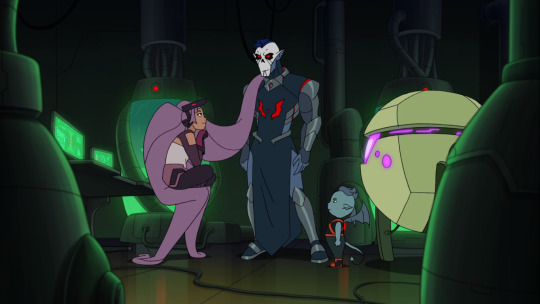
First some background . . .
Entrapta is a princess like no other who rather tinker with machines and inventions. She sees things others don’t while finding it difficult to read others emotions and social etiquette. At the Princess Prom, she was by herself observing the crowd and the only one not dressed for the occasion.
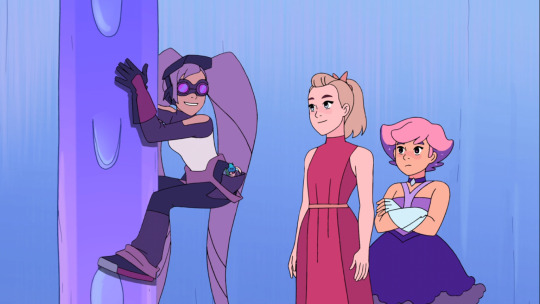
.She’s not a bad person and she’s really quite friendly, but her motivations vastly differs from others. Entrapta’s easily distracted by any new fancy tech and will dash off to investigate while forgetting about the rescue mission she volunteered for. Sometimes she gets confused by social interactions and focuses on inane things at odd moments.
She’s autistic and beautiful and I simply adore her! Unfortunately, the characters don’t feel the same way. Her servants are almost frighten of her, Adora and the Princesses get frustrated with her, and Catra ignored her when Hordak began favoring her. Poor Entrapta is aware of the issues around her and sadly, isn’t angry with Adora for ‘abandoning’ her and isn’t too sure whether Catra is her friend or not.
Then she meets someone who not only is at her level, but also feels out of place with his surroundings.
.
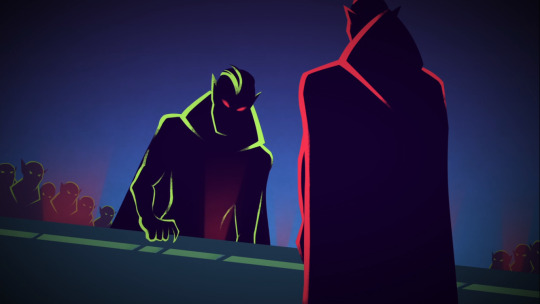
In season three, we learn about Hordak’s origin. Of how he is a clone of Horde Prime and due to a defect in the cloning process, he has a degenerative disease which causes Horde Prime to reject him and send him to die on the front lines. Yet, a portal sends him to Etheria where he sets up his own Empire from the remains of his crashed ship.
He sees Etheria as a backwater planet which I can sympathize. Etheria has no high level tech, living almost as medieval times with magic. Any technology the Horde has was reverse engineer from his ship. Also, he used to working with fellow clones of himself with the same intelligence and possible the same attitudes and mentality. He’s forced to work with Etheria natives that cannot meet his expectations nor understand his goals or reasoning.
He’s distant from his subordinates and rules the Horde from his Sanctum which he never leaves. It was a place of solitude until Entrapta comes along.
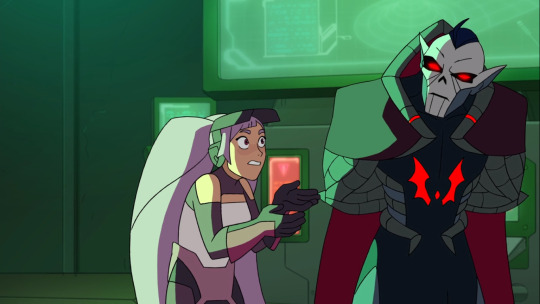
I love how she can naturally skirt around his authoritative mien and throw him into a state of confusion and uncertainty. She’s an odd creature to him and he’s isn’t sure of how to handle her. See the above image about how she’s excited about the prospect of portals and he’s studying her, almost intrigued and trying to figure her out.
Unlike Shadow Weaver and Catra, Entrapta isn’t looking for power or validation. She’s purely in it for the science and Hordak was in need of something who could meld technology with magic to make the portal work. Thus a sort of partnership was formed between them and it laid down the groundwork for what came in season 3.
56 notes
·
View notes
Text
Delta Rune Speculation
So it’s been two weeks, and there’s already 200 plus fics on AO3 and dozens of remixes and arrangements of the soundtrack on YouTube. That’s not even touching on the theories that are coming together. I recently saw one theory that double downed on the whole discarded classroom with toys thing, with the Darkners basically being a “Toy Story” scenario and the Spade King trying to pull a “Small Soldiers” scenario.
And while the parallels between the Darkners and assorted toys, and the layout of the Dark World and the Classroom, are all too much of an overlap to ignore, I suspect that there’s something more to the whole game than simply toys coming to life and wanting revenge for not being played with. I had some thoughts that I contributed in my reblog of that person’s theory, but this post is a little bit more meta, and concerns itself primarily with the tone of the final game, if and when it gets completed. But first, we need to talk a little bit about Undertale. I’ll make it quick, I promise.
Simply put, the big thing that made Undertale stand out was how your choices distinctly affected the world you were in, and the way people responded to you based on those choices. The sheer difference in tone and content between True Pacifist and Genocide is about as different and distinct as you can get in any game that features multiple endings, especially when many games opted to make the multiple endings contingent on last second choices (Deus Ex instantly comes to mind) rather than being something that you had to commit to. Not only that, but even the small choices in the sense of dialog, the order in which characters were spoken to, and even the use and contents of your inventory meant that the game had more “immersion” in the sense of responding dynamically to player choice than a lot of Triple A games with hyper-realistic graphics engines.
The way Undertale responded to different choices was a twist, then attraction, and finally a statement about how people saw the world and interacted with it. Especially those who thought that actions taken in this isolated digital environment had no consequences beyond that environment. It was a game about how people acted when they had tremendous power to influence the world.
Therefore, I think that the meaning of Delta Rune’s “your choices don’t matter” and “nobody can choose who they are in this world” is that the game will be about how people respond when confronted by circumstances they can’t control.
For more of my rambling, click the link below.
I’ll be addressing three main points: The nature of the Dark World and the Fountains of Darkness, the Dichotomy between how choice is handled in the Light and Dark Worlds, and the few clues that we have about W D Gaster and his influence.
1. The Nature of the Dark World.
The playing card themed enemies, the puzzle pieces, the chess board and the crowned checker piece, plus some of the hints about Ralsei’s nature and origin, all indicate that the Darkners have some connection with the toys in the unused classroom and probably the materials and objects in the supply closet as well. (I still do not know what those things were in the opening area of the Dark World that shot bullets at Kris, or the significance of all that black gooey dark stuff apparently coming out of the eye shaped structures.) Susie is not the type of person to let her guard down and just skip class with Kris while playing make believe all day... at least not at the start of the game... so the events of Chapter One had some foundation in reality.
This brings us to the fountains and the legend Ralsei shares. Everything hinges on a classic balance between opposing forces, in this case Light and Dark. Too much of one or the other will break the world in some way, and in this instance, there is an excess of Darkness. Under the direction of the mysterious Knight, and the Queen that only Jevil mentions if you kick his ass, the Spade King is seeking to upset the balance by increasing the Darkness. Assuming that Kris, Susie, and Ralsei don’t stop these fountains, then the same force at work in the Dark World that drew Susie and Kris into it will spread beyond the school, and into the rest of the town.
It is my position that Darkness in this case, represents Imagination, and its ability to create worlds symbolically. Keeping a balance between the physically real and the mentally real is important; too much of the physical and you end up in an All Work And No Play Makes Jack A Dull Boy scenario. The other way around, you spend too much time daydreaming - or consumed by anxiety - to deal with the actual problems in front of you. And just by talking to the people in Hometown after school, we can find all sorts of stuff that bothers people. Toriel and Asgore’s estrangement, Noelle’s father and her worries about him, Alphys being lonely, and so on. In a Dark World where people’s thoughts and ideas take on physical forms, these everyday worries become living nightmares. It is THAT scenario that the Fun Gang will have to prevent or reverse from Chapter Two onward.
2. In Which World Do Choices Not Matter?
No matter which way you play Delta Rune, you leave the Dark World at the end. In that sense, none of the choices you made matter. Only if you did a pacifist run, you have the chance to go back and say goodbye to a number of characters you encountered before. Sort of an Undertale Epilogue Lite. If you went to town on everybody, you get chased back to the Light World instead. So in a way, your choices DID matter.
On the other hand, no matter what you do in the Light World, you’re still Kris, the token human in a monster town, with estranged parents and an older brother that probably outshines the heck out of you if all those trophies and award certificates mean anything. You can’t help smooth things over between Toriel and Asgore, you can’t even hint at Undyne and Alphys getting together, and no matter what you tell Noelle, she’s still got a one track mind regarding Susie and is concerned that you are pranking her again. About all you can do is choose to be mean or nice to Onionsan; everyone else still thinks you’re some weird creepy human kid with a history of pranking, whose main redeeming feature as a person is apparently some skill at the piano. Nothing you do can change that, even if being more talkative than normal is out of character enough for folks to notice.
But then again, in the Light World, nobody can choose who they are. Choices don’t matter because so much of Kris’s life is defined by everyone else. And even those lives are more defined by primal fears like Toriel’s loneliness and deep seated resentment, Asgore’s pushover-ness, Mr. Holiday’s health, Alphys’ anxiety, and so on and so forth.
As the Dark World starts to influence the rest of town, and imagination and thought starts to overwrite physical reality, the Fun Gang’s choices will suddenly carry more weight. Maybe not enough to change everything once the Fountains are sealed, but enough to make a difference. Such as the difference between Noelle being totally inconsolable over the loss of her father, and Noelle having the opportunity for closure. Or Toriel at least agreeing to be civil towards Asgore, even if they still never get back together. Or Burgie being able to find a much better job. :P
Or Kris being seen not as “the human” or “Asriel’s brother” but as Kris, a person in town with more depth than just a history of pranks and a creepy disposition.
3. Oh Gaster, Where Art Thou?
The announcement for the Demo, the “character / vessel creation” process at the beginning, the music playing during the vessel creation sequence, the Man who gives Kris an Egg if he is found, the Entry 17 Sound FX from the cell phone in the Dark World, and the slowed down version of the same sound playing around that Mysterious Bunker south of town all point towards Gaster’s involvement in the events of Delta Rune, one way or another. Given the limited information available so far, it’s not entirely clear if he’s working towards increasing the amount of Darkness, towards stabilizing the imbalance, if he’s simply observing events with no regard for the outcome, or if for some reason he requires US as observers for the events of Delta Rune, whatever they are.
But using what little we know, we can make a few educated guesses.
First, the Egg Kris can get from the Man behind the tree, who cannot be seen and will vanish if the Egg is not accepted, is the ONLY item from the Dark World that stays the same back in the Light World. The swords become pencils, and all the other stuff accumulated in the Dark World becomes the Ball of Junk that Kris does not want to throw away, but the Egg is still an Egg. Sort of. It can be put into Asgore’s Fridge, but if this is done, somehow it turns the pickle jar into another Egg. Which raises a number of questions. Unless you hold onto it for later in the full game, or throw it away, this is the only thing you can do with the Egg as far as I know. Almost as if the only reason it exists in the world is so that Asgore can have something to eat besides pickles.
Second, Jevil’s misanthropy follows his interaction with a visitor to the kingdom, and I do not remember if this visitor was specifically stated to be the Knight mentioned by Jevil or the Spade King. The way he treats the entire world like a game fits the same meta as Flowey’s attitude after being stuck in a Determination fueled time loop for ages in Undertale, but it also aligns with the Darkner world’s toy theme. And of course Seam drops the “darker yet darker” line on us regarding his view of the world after dealing with Jevil... but at the same time, this is a literal Dark World. Kris and Susie noticed that the light was getting low in the school hallway before they even stepped inside the supply closet, so it’s not out of the question that Gaster’s experiment, whatever it was, involved discovering the Dark World.
And, while this is purely me stacking conjecture on top of conjecture here, keep in mind what I said earlier about the Dark World being a world where the power of Imagination can literally create a world. Then consider one of the lines of the Gaster Followers from Undertale: Gaster fell into his own creation. As Gaster was the Royal Scientist, it seemed logical to infer that his creation was some sort of machine or technology, such as the CORE or whatever is under the sheet in Sans’ workshop in Snowdin Town. But maybe what he fell into was a completely different reality... possibly one of his own design.
(Note to self: Undertale / Secret Of Evermore Crossover Fic. Add it to the list.)
Third, the vessel we are asked to create at the start of Delta Rune has the word Goner as part of the filenames of the assets. Its appearance also matches that of the other Gaster Followers in Undertale; greyscale, uncanny valley, and just different enough from the character we end up seeing in the game (Kris) to make the similarities stand out. Keeping in mind we still don’t know what the significance is of the Gaster Followers or Goners is in Undertale, or how exactly they relate to Gaster himself. In the completed game, though, we may have the opportunity to find out... behind the bunker doors south of town, where the slowed down Entry 17 sound is playing. (It’s also location 17, so there’s a definite number element going on here.) The thing about bunkers if that they are almost always made to protect something inside them. So unless this is a fallout or storm shelter for the folks in town (and we can’t read Gerson’s book in game so we have no idea what the political climate is between humans and monsters is in this world, though if they were really bad then somebody would probably mention it in dialog) then it’s probably intended to keep the people of the town from finding something. Like an experiment that went wrong. Or went right, for that matter.
Or, maybe the bunker is one of those less common cases where it protects everything outside it by locking something inside, for any of the reasons already stated. Either way, there might be a real True Lab situation down there.
Finally... has anyone else besides me noticed that the graphics in the background during the Vessel Creation Sequence look almost exactly the same as the background of the Fountain of Darkness that Kris and Susie use to go home, just without the playing card suites? Where exactly is that taking place?
One last thing that brings my whole post full circle; regarding the ending cutscene before the credits and Don’t Forget song, I wonder if the entire thing isn’t just Kris’s nightmare; the body rips out the Soul that used to be inside and locks it up, and is free to do who knows what after that. If Kris is aware that the player is influencing them in any way, that whole sequence could be brought on by their fears about losing autonomy, either partially or entirely.
Which brings us back to the whole “your choices don’t matter” thing.
71 notes
·
View notes
Text
Best Herbs And Food To Cure Erectile Dysfunction Naturally
It not only plagues earlier generation about the is now common one of several young as well. Whether or not you believe that they do have specific medicinal benefits, one thing the teas do have is a high vitamin content. Trintrins have no effect. I was amazed to see a headline saying that Ballincollig and Carrigaline have been identified as burglary hotspots. Though a family history of cancer may increase your chances of getting it, there are steps you can take to minimize your risk. Many men are already using Erectile Dysfunction and supplements like it, and regular use may aid performance and help men fight back against the aging process. Please take a minute and check out our 100% risk-free, money-back guarantee report which is helping hundreds of men naturally cure impotence. This all happens out of fear of abandonment. Post that phase, the blood drains out. The study further said the patient’s condition did not improve after doctors tried out many treatments. The results from this study confirmed that Cappra® is well tolerated when it was used for the treatment of ED. Improving the quality of your sleep will bear positive results for your romantic and physical relationship. With consistent and proper treatment, sleep apnea may be successfully managed and controlled. Erectile dysfunction treatment in gurgaon ; outside of new delhi.the there are many methods for treating erectile dysfunction. However, there are some supplements on the market that you almost certainly want to avoid. In terms of applications such as food and beverage, cosmetics, dietary supplements, and personal care, it is the dietary supplement segment which is expected to lead in the pychnogenol market. Extracorporeal shockwave therapy is a relatively new treatment for erectile dysfunction that the united states food and drug administration has warned. Summary of the evidence on avanafil for treating erectile dysfunction to inform local nhs planning and decision-making. Compare risks and benefits of common medications used for erectile dysfunction. The most common types of medications for high blood pressure that are known to cause erectile dysfunction quite often are thiazides and beta-blockers. Then you feed them to animals like lions and tigers and eat them, so you are eating highest on the food chain. What's important is their new name sounds like some kind of medicine or drug. You should try to lower your cholesterol intake by eliminating red meats, drinking fat free dairy and avoiding fattening foods (like fast food). Finally, some drugs can artificially lower your PSA, including finasteride, which is a treatment to prevent prostate cancer. There was a time when cancer meant inevitable death. Moreover, people notice an increase in their total exercise time as a result of Tadalies usage. In many conditions it is not possible to increase the length or widen it because the shape and structure is determined by genetic factors and it cannot be altered at a later stage. So what are the possible causes of stage fright? Eat foods that are high in fiber which include grains, lettuce, fruits and vegetables. High blood pressure can often referred to as erectile dysfunction. 7. Artichoke Tea has a very high antioxidant level. 66. Nettle & Peppermint tea is used to treat irritable bowel syndrome, nausea and vomiting. 52. Kukicha Tea is a Japanese blend of tea made of stems, stalks, and twigs. Herbal remedies for erectile dysfunction uk ed medros and fast treatment for erectile dysfunction (ed) that can reverse their problem without medication and erectile. You are advised intake of this herbal supplement two times daily 30 minutes before taking meals. The investigators found gene variations in a specific spot in the human genome near the SIM1 gene that are significantly associated with an increased risk of impotence. Our medical team is ready to assist you to understand the options that are available for you. Tell your doctor and pharmacist what prescription and nonprescription medications, vitamins, and nutritional supplements you are taking or plan to take. Therefore, the author recommends caution when taking any of the aforementioned herbs, supplements or foods for medicinal purposes. It can do this because it works by lowering cholesterol. Viagra lost its patent protection in the UK in June 2013 so generic drugs, called sildenafil, canadian pharmaceuticals online can now be marketed. It is wonderful how know-how can accelerate your progress! Some of them don't even use it at all. Looking for artichoke recipes? But these methods often do not meet your lifestyle because you cannot accept to yourself that you need to limit your mouth eating your favorite food. Which Erectile Dysfunction pill took home the Editor's Choice Award? Erectile dysfunction (ED) affects both the man and the woman. It is normal for a man to feel embarrassed, rejected and inadequate due to ED kind of trouble that he is encountering. We check penile function with a simple test at our melbourne and brisbane clinics. And what are those? Nasal and abdominal breathing are the hallmarks of optimal breathing. Beriberi, pellagra, chronic alcoholism and chronic gastrointestinal diseases are among the nutrition disorder implicated in Polyneuritis.
1 note
·
View note
Link
Your body has been supporting you all through your days and will continue to do so for the rest of your lifetime. But after working tirelessly, it is natural for it to get a little weak. As you age your body undergoes several changes. You also have to make some changes to help your body get through this transition of aging smoothly. Here are some tips that will help you get through aging gracefully and also help maintain your health.
Make some lifestyle changes
When your body undergoes changes so should your lifestyle. You should take up a senior-friendly diet that comprises healthy nutrients and vitamins. Try to reduce unwanted fat and carbs intake. There is no universal diet that suits everyone. Each body ages differently so your diet has to be planned according to what your body can support and what it cannot. Also, stay hydrated and get adequate rest. Sleeping properly has so many benefits while aging like keeping your mind fresh and active, reducing stress, and rejuvenating your body. Avoid smoking and alcohol consumption.
Stay active and stressfree
‘A healthy body is an active one’. The more healthy activity you give to your body the less brittle it gets. But do note that excessive exercise could have reverse effects rather than good ones. Your activity routine could comprise anything from walking, cycling, aerobics, swimming, dancing, or yoga. It is recommended that you exercise at least 30 minutes a day for 5 days a week. Exercising not only keeps you fit and healthy but also reduces stress and enhances mindfulness.
Go for regular body check-ups
As you age your body functions might not be as accurate and effective as they used to be. This could give rise to ailments that further affect your body. So stay alert for any symptoms, abnormal changes, or discomfort that arises in your body. Ignoring symptoms could have adverse effects on you. Furthermore, most health issues can be treated effectively and cured if detected at the early stages. Go for regular full body check-ups to know about the exact condition of your body and to take care of it properly.
Get new hobbies and spend time with friends
When you get older you get more leisure time. Spending this time in a fun and useful way could make aging enjoyable. Involve yourself in new hobbies and activities. Have a healthy friend circle around you who are positive-minded and want to stick with you during your aging. Being with friends is the biggest stress reliever.
Accept the aging process positively
Many people find it very difficult to accept the changes that are happening to them. The changes that arise in their health or appearance tend to worry and frustrate them. Many people affected by premature aging are known to go through severe stress and depression as the changes in their appearance seem too drastic for them. This takes a toll on their mental health. But we should all realize one thing. Aging is a natural process that everyone undergoes. No one can skip it. Hence welcome your aging positively and accept the changes. Make new changes in your life so that you help your body to maintain itself in sound health.
For healthy aging, you should take great care of yourself and be surrounded by a group of friends who keep you happy and entertained. This might be difficult to do on your own or with a busy family. This is why you could always shift to senior assisted living facilities like Antara Senior Care.
At Antara, professional caretakers have an organized way of taking care of you so that you don’t miss out on anything. From providing customized diet plans, regular medical check-ups, 24/7 clinic and ambulance service, flexible care options based on your needs to having a friendly environment for healthy aging and taking care of you as their own Antara Senior Care really go an extra mile for you. You could also consider their home physiotherapy services to get expert consultation on the kind of exercises you should do. Since it is at your home everything from the timings to duration is under your control which makes the whole process a lot easier and flexible for you.
For more information, visit: https://antaraseniorcare.com/care-homes/
0 notes
Text
Laser Assisted versus Traditional Cataract surgery in India
Our eye is a complex visual organ, comprising of the conjunctiva, Iris, Lens, and Retina as major parts. Cataracts are cloudy areas that form in the lens, which is normally transparent. They are the main cause of vision loss in people aged over 50 years. A cataract is formed as a result of protein clumping within the eye lens.
As a result, Light does not pass through easily, and vision becomes blurry, like looking through a fogged-up window. The cloudier the lens, the worse the vision will be.
The eye lens has multiple layers, having outermost as the capsule. The layer inside the capsule is the cortex, and the innermost layer is the nucleus. Cataracts are named for their location in the lens; It can be a nuclear cataract, cortical cataract, or A posterior subcapsular cataract.
In the United States in 2010, there were 20.48 million cases, rising to 24.41 million in 2015. By 2050, nearly 50 million Americans are expected to have cataracts.
Fortunately, with advancements in medical technology, cataract surgery is now more effective and safer than ever before.
Both traditional and laser-assisted cataract surgeries work to reverse the cataract process by removing the clouded natural lens of the eye and replacing it with an artificial lens, known as an IOL.( Intraocular lens)
In this article, we will highlight the major differences between laser-assisted cataract surgery and traditional cataract surgery.
Traditional cataract surgery
Cataract surgery is one of the most commonly performed procedures in the world and provides excellent results. Surgeons usually operate on one eye at a time, even though cataracts may be present in both eyes.
Cataract surgery is an out-patient basis treatment, allowing you to go home after a short stay at hospital. Traditional cataract surgery is also referred to as phacoemulsification and is performed by hand with ultrasonic phaco equipment. During traditional cataract surgery, the eye surgeon will make a small opening on the side of the cornea with the surgical keratome.
The opening is so tiny that it usually does not even require sutures, and the eye tissue heals by itself. An ultrasonic probe is then used to break up the cataract in your eye and the pieces are sucked out through the opening.
An artificial lens is then inserted into your eye where the cataract was. Thus, it is widely accepted as a popular technique for treating cataracts. The process takes only 5 to 10 minutes.
laser-assisted cataract surgery
Cataract surgery is aimed for seeing more clearly and new lasers and premium lenses have made it possible to achieve better vision. During laser cataract surgery, the chance of any human error is greatly reduced. In laser cataract surgery, a laser is used to make the incision.
Energy from the laser is used to weaken the cataract. After that just like traditional cataract surgery, an ultrasonic probe is then used to bust the lens into smaller pieces which are then suctioned from the eye, and an intraocular lens (IOL) is inserted.
It creates a more reliable, repeatable, precise incision than a surgeon can do by hand. Even a very good surgeon can’t make a perfect circle as precisely as a laser can. The laser is useful when a cataract is dense or the opening is difficult to create. Lasers precisely pinpoint the location, depth, and length of the incision required, which makes it more effective and free from infection.
Benefits of Laser Cataract Surgery
Reasons to choose laser cataract surgery over traditional treatment are numerous.
More precise vision correction
Laser surgery is more accurate having precise dimensions as a result of 3D imaging/map created by the LenSx laser technology. Lasers are found to be providing safer and easier cataract removal.
Less energy consumption
Patients undergoing laser-assisted treatment need 45% less ultrasound energy in comparison to conventional cataract treatments.
Correct two issues at one time
Laser surgery has the ability to correct astigmatism along with the removal of the offending cataracts and correct the shape of your cornea as well.
Cellular preservation
Endothelial cells once damaged in the eye cannot be regenerated. Laser surgery causes less cell damage and maintains eye health.
Faster recovery time
As the Laser requires less energy to break up the cataract, it is seen that patients experience reduced, post-operative corneal swelling and that leads to faster vision restoration.
Before reaching to any conclusion, schedule an appointment with one of our experts or to know more about our various Laser Eye Treatment options and feel free to contact us at 022 61549999 or visit our clinic at Bandra and Kandivali.
Tag = Cataract treatment in Mumbai, Cataract treatment in India, Eye hospital in Mumbai, Eye Specialist in Mumbai
#Cataract treatment in Mumbai#Cataract treatment in India#Eye hospital in Mumbai#Eye Specialist in Mumbai
0 notes
Text
We Are Originals
Previous Chapter
AN: So sorry it’s taken so long to update this! I tend to start to many things at once :/ Anyway, here you go!
Summary: When Thomas stops a young man from committing suicide, he is shocked when they turn out to look exactly alike. Life is not nearly as simple as he thought it was… Humanau, thesidesareclonesau,
STORY IN GENERAL WARNINGS: depression, anxiety, suicide attempt, swearing
Taglist: @anotheranimeaddict @tree4life25 @walrus-flail @countessmissyshort @swiggtyswag19 @michealawithana @fandomsandanythingelse @celiawhatsherlastname @anxious-but-whatever @justanotherpurplebutterfly @bookwormravenclaw @icecoldparadise @thelogicalloganipus @bookwormravenclaw @lizzysperil @lollingtothemax @sunnywithachanceofsunflowers @istolelittleredshoodie @lynlinked @logicalpasta @moxiety--sanders101 @poisonlyra @itcouldbegay @captainswan618 @freepaperie081 @citygjrl @preyed-llama @soiguessthisismyusername @princeyssash @isdisorigionalenoughforyou @all-the-fand0mz @pailettehazel @omlwhatamidoing @emerging-writer @loverofpizzaandallthingssweetloverofpizzaandallthingssweet
Everything: @sanders-trash-4ever @istolelittleredshoodie @redundant-statements-for-400 @lilbeanblr
Chapter 4
Thomas had been reduced to a nail-biting, hair pulling mess by the time he was able to use the car to drive to South Carolina.
Okay, so he could maybe, maybe rationalize the existence of one person, maybe two people that looked like him.
But three other people?
Maybe Joan was right. Maybe he was going crazy. Maybe he should get help.
Thomas’s knuckles were white on the wheel as he pulled into the guest parking lot in front of the university Logan worked at. He sat there for a long minute. Just… breathing.
He couldn’t panic. He needed to figure this out rationally and running off like he did a few days ago was not going to get him any answers. He drove the seven or so hours out here and now he just needed to find Logan. Which reminded him, how exactly was he going to do that? Logan hadn’t set up a place for them to meet. He supposed he could figure out where the science area of the school was and start there?
Grumbling under his breath, Thomas opened the door and stepped out into the day. He walked toward a map beneath some large trees, hands in his pockets. He was suddenly self-conscious as he entered a small crowd of walking students. The students laughed and studied and listened to headphones and some unfortunate soul was sleeping in a corner, and it was all so… normal.
Thomas had never felt so completely disconnected in his life.
It didn’t take long to find the building he needed, and on his way over, he took out the phone he was borrowing from his brother and texted Logan quickly. As usual, the message didn’t go through. Well, fine.
Thomas pushed through the swinging glass doors and walked down the hallway past groups of semi-panicking students. He waited for the hallway to clear a bit before continuing on, hoodie over his head.
“Hey, do you know where Professor Edison’s office is?” he asked a girl.
She frowned at him. “Uh, wow. I… are you related to him?”
“Cousin.”
The girl nodded. “Yeah. He’s in a lecture now, though. I just passed by. Room 221.”
“Thanks.” He was a bit early, then.
Thomas kept going, head down. There were remarkably few people that recognized him, which he was grateful for even if he didn’t quite understand it. 219, 220, 221. There.
He stood on his tiptoes to look through the window in the door. The lecture hall was large and shadowed and circular like a mini arena. Down there at a podium stood a young man with a laser pointer. Above him, the slideshow displayed what appeared to be a detailed drawing of an atom? The lecturer gestured simply at it, his eyes lit up with excitement. He was wearing glasses just like the other one had been, (Patton, wasn’t it?) but while the glasses had made Patton look almost childish, they gave Logan a look of intellectual superiority. He was wearing a sharp button-down and tie that Thomas wouldn’t be caught dead in, and it suddenly made sense why people were not immediately recognizing him. Logan carried himself like an adult. The teacher. And Thomas most definitely did not. He decided he’d think about that later as he eased open the door and sank into a seat. He’d hoped to come in completely unnoticed, but Logan glanced up at the door and his speech faltered. A flicker of something passed through his eyes, and Thomas gave him a tight smile.
“A-as I was saying,” He fixed his glasses. “if we reverse the polarity of the neutron flow…”
Thomas didn’t hear much of the rest of his lecture. Although, admittedly, Logan was not too bad of a teacher. He seemed stern, but he was willing and enthusiastic when students asked questions, which Thomas wouldn’t have expected. It felt like a matter of minutes until Logan’s lecture ended. Students zipped up their backpacks, put on coats, and filed out of the lecture hall. Thomas went with them. It was easier than going against the flow or the crowd.
He exited into the hallway and waited, arms crossed. He checked his watch. Logan should be coming out any second now… Sighing, Thomas walked up and down the hall boredly. He was jittery and anxious and he just wanted answers.
Suddenly, a hand grabbed his arm. He yelped as the person pulled him back. Into a maintenance closet.
The door clicked shut and Thomas was chest to chest with a complete stranger.
The other person stepped back. “What do you think you’re doing?” he hissed.
“Finding you! You said-”
“I know I said-” He growled and reached up to pull on a string. A small light bulb popped on and Logan was standing there glaring at him. “I have a life that I have built here and I do not need some idiot rushing around ruining everything. Did anyone see you?” Thomas opened his mouth to protest, but Logan kept on. “Of course people saw you. You could be putting all of us in jeopardy with this foolhardy behavior!”
Thomas crossed his arms. The top of a mop was jabbing into his side and he struggled to keep his balance. “Look, I just want answers okay? Can we talk somewhere that isn’t a broom closet?”
Logan considered his.
He shook his head. “No. No, we cannot be seen together here.”
What was his problem? Why was he so freaked out? So there were a few people that looked alike, big deal. Logan wasn’t acting like it was a little thing, however. WHY?
Logan chewed his lip, and his eyes glazed as he thought about something. “Yes. Okay, so there is not an easy way to say this. So I will simply state it.”
Thomas cocked his head. “Okay?”
“You and I are clones along with the others.”
Thomas blinked.
What?
He snickered. “Yeah, funny. I didn’t take you as the practical joke guy. Now, what’s the deal? What was it, quadruplets? I didn’t even know that was a thing.”
“If this is all, it would be quintuplets, actually,” Logan said. “Roman is also one of us.”
Thomas’s mind skipped a few tracks before he forced himself to just accept that. “Five. Five kids.”
“Yes, or we would be if we were born normally. But we were not. I have done the tests and the signs are quite obvious when you are looking for them. For one, we are not all exactly the same age, in fact, there are several month gaps between all of us. Also, there is a genetic signature which simply does not exist in nature. I could say more, but I imagine there is little likelihood of you believing me and I honestly do not have the time. So, if you don’t mind-” He reached for the door but Thomas grabbed his wrist.
“Hey, wait. You can’t just say that and then walk off.”
“Can’t I? I think I am. Right now.” He pulled away from Thomas and started opening the door.
“If you walk out, I’ll follow you.”
That stopped him.
“You must understand, we cannot be seen together. There are people who would…”
Thomas waited. “What? People, who would what?”
Logan pursed his lips, his voice low. “It is sufficient to say that we have disappeared before. Woken up without memory of where we were. When Virgil disappeared, we all assumed he had been... taken. We had found microphones on our phones, in our houses. People were watching us. Studying us. We relocated and thought we had them off of our backs until Virgil disappeared.”
Thomas could feel the blood draining from his face.
The process of cloning is actually quite simple, someone had told him once. They do it to animals all the time.
No. He wasn’t actually considering this. But Logan was making sense. Too much sense.
Breathe, Thomas.
“If you ever feel like someone is following you, leave as quickly as possible. I have…” He dug out of his pocket an old flip phone. “Here. Use this to contact us. We have ensured that it isn’t tapped. If anyone calls you, it is one of us. I am… apologetic that this is how things are, but this is how it is. Now, if you have an ounce of sense, you will leave and never contact any of us for your own safety.”
Thomas took the phone dully. He couldn’t think. Every thought was whizzing around too quickly for him to grab hold of.
Logan narrowed his eyes. “Are you alright?”
“Just reevaluating my existence, you know,” Thomas laughed even though nothing was funny. He was dizzy and nauseous but, yeah, whatever.
“I… I have parents. I have a brother. I’m not…”
Logan raised an eyebrow skeptically. “There is a high probability you were adopted.”
And there was another pang right there in his gut. Would his parents really lie to him like that?
Yes.
“I need… air.” Thomas opened the door, and Logan stayed inside the closet, arms crossed. “T-Thanks for the phone, I guess.” Thomas swallowed dryly. OutsideIneedtogetoutside.
He turned to walk away, but Logan grabbed his arm. Thomas looked back, surprised. Something had unexpectedly softened in Logan’s eyes. His shoulders slumped, and he suddenly looked very old and very tired. “I apologize for my bluntness. The search for Virgil has had all of us at our wit's end and… I am grateful that you found him.”
Thomas nodded. “Okay.”
Logan debated inwardly before coming to a decision. “Against my better judgment, I imagine this is difficult for you. You ought to have an official introduction. Perhaps… a meeting between us all can be arranged.”
The thought had Thomas wanting to panic immediately, but he found himself nodding. “I would appreciate that.” He didn’t believe him. Not a chance. But he still wanted to meet the others.
“Good.” Logan glanced out at the hallway. It was still empty. “I will speak to the others and text you the address and time. It will be within the next few days in all probability.”
A meeting. He could… he could do a meeting. Thomas nodded again and Logan let go of him. His, what was he, a brother? His brother fixed his glasses and loosened his tie slightly. “Thank you,” Thomas said.
“You are welcome.”
Next Chapter
#yall#here it is#fan fiction#fic#fanfic#fanfiction#sandersides#sander sides#sanders sides#thomas sanders#logan sanders#multi-chapter#clones#au#to be continued#boop da snoot#yeah#ff
106 notes
·
View notes
Text
Could I have low testosterone?
Low testosterone (also known as low-T) is more common than you think and it can negatively affect your body in more ways than one. Due to the wide variety of symptoms, low-T can often be confused with other conditions such as anxiety, erectile dysfunction and aging.
Approximately one in four men over the age of 30 experience low testosterone, but less than 5% are diagnosed and treated for the condition. For starters, most men don’t necessarily enjoy taking trips to the doctors and would rather just accept that “this is just how their body is.” Alternatively, these symptoms of low-T can be attributed to other, less complicated, conditions.

So, how do I know if I suffer from low-T?
Great question! Testosterone is a natural hormone responsible for the normal growth and development of certain male organs and for maintenance of critical masculine traits such as bone and muscle mass, facial hair, sperm production, and your labido.
The symptoms of low testosterone could be wide ranging and can impact all aspects of your life, not just your sex life. If you think you may be suffering from low-T, you could be experiencing one or several of the following physical and psychological symptoms:
Physical symptoms of low-T:
Erectile dysfunction
Premature ejaculation
Lack of energy, fatigue
Decreased endurance
Muscle weakness, loss of strength
Aches, joint and muscle pains
Deterioration in work performance, sports
Weight gain, increased abdominal fat
Increased hair loss
Psychological symptoms of low-T:
Low sex drive
Decreased motivation
Decreased enjoyment of life
Low self-esteem
Depression
Anxiety
Grumpy, irritability
Mood swings
Brain fog
Based on the lists above, you can see that some of these symptoms are quite general and can also apply to other health complications. Which is also why low-testosterone is either ruled out or not thought of altogether for most patients. Luckily there are treatment options available so there is no need to avoid the issue, and early diagnosis and treatment can change your life.
What do I do if I think I have low-T?
If you feel as though you may have low-T based on the above list, you have a few options.
1. You can contact your doctor to schedule an appointment and get tested for low-T.
2. You can book a virtual appointment with one of our doctors here at ON MEN from the comfort of your own home. Our doctors will conduct a thorough testosterone and hormone check for you to see where your testosterone levels are and then work with you to formulate a treatment plan that’s right for you.
Whichever route you take, you will be required to get an intensive blood work panel done to check your base line testosterone levels.
Testosterone Replacement Therapy as a Solution
Testosterone replacement therapy (TRT) is a unique type of hormone replacement therapy designed to restore healthy testosterone levels in someone who suffers from low-T.
TRT works by giving your body the testosterone it needs to function at its optimal levels . Testosterone is the primary androgen in males (and females) and has an impact on many biological processes that are necessary for your health and longevity.
For example, low-T is associated with an increased risk of type-2 diabetes, metabolic syndrome, cardiovascular disease, and a myriad of other debilitating health conditions. Having low-T also makes it significantly harder to build (and retain) muscle mass, since testosterone is a potent anabolic hormone and directly impacts muscle protein synthesis.
Intuitively, if your body doesn’t produce enough testosterone on its own, your health will start to suffer until you fix the issue. Thus, TRT works by bringing your body back to a healthy range for testosterone, which then slowly begins to reverse the symptoms of low-T. Once a steady baseline dose of testosterone has been established on TRT, most men notice an improvement in their energy levels, vitality, and quality of life.
How does Testosterone Replacement Therapy work through ON MEN?
Health Assessment Once you complete your online health assessment questionnaire, we will send you a referral for blood work. Your initial virtual visit with the ON MEN physician cannot be scheduled until the blood work is complete.
Personalized Plan When the results are ready, you’ll have an in-depth video or audio call with a Canadian licensed ON MEN doctor who will spend time getting to know you, explain what your results show, and recommend a personalized treatment plan.
Treatment Options Your personalized meds will ship directly to your door every 3 months through one of our licensed partner pharmacies, so you can focus on feeling your best while we handle the rest. Available treatment options include custom compounded topical testosterone cream or injections.
Quarterly Follow ups You will be required to conduct blood work every 3 months during the first year of the treatment, and every 6 months thereafter. Once we receive your blood work results, we will schedule your virtual quarterly follow up appointments with one of our ON MEN providers, to discuss ongoing progress and tweaks to your treatment plan. Through ON MEN, you get unlimited access to our medical and pharmacy team for ongoing care and answer your questions.
Conclusion
Low-T is not uncommon but it’s always worth checking to see how your blood levels are to decide whether or not your need to take action. Luckily, here at ON MEN, our TRT treatments may be covered by your insurance. You’ve got nothing to lose by checking your levels today and the positive effects of the treatment can change your life!
ONMEN Canada
Our team of licensed Canadian doctors and pharmacists prescribe you 100% authentic medications, approved by Health Canada and shipping from within the country.
0 notes
Photo

Beyond No-Self
By His Holiness the Dalai Lama
The teaching on the twelve links of dependent origination is common to all Buddhist traditions; however, the interpretation of the twelve links, their processes, and particularly the explanation of the first link, ignorance, is different for the Madhyamaka school than it is for the other philosophical schools.
The other schools define fundamental ignorance as grasping at the self-existence of the person. Grasping at the self-existence of a person means believing there is a self that is somehow distinct from our body and mind — our aggregates. Such a self is thought to act like a master over the physical and mental components of a person.
The seventh-century Indian Buddhist philosopher Dharmakirti gives an example of this belief in his Exposition of Valid Cognition (Pramanavarttika): Say an old person whose body is deteriorating and is full of aches is given the opportunity to exchange his body for a much healthier body. From the depths of his mind would emerge a ready willingness to take part in such an exchange. This suggests that deep down, we believe in a self that is distinct from our body, yet somehow master over it.
Similarly, if a person with a poor memory or some other mental deficiency were given an opportunity to exchange his or her mind for a fresh one with superior cognitive powers, again from the depth of the heart would arise a real willingness to enter into the transaction. This suggests that not only in relation to our body but also in relation to our mental faculties, we believe in a self who would benefit from such an exchange, a self that it is somehow the ruler or master of the body and mind.
The other schools define grasping at self-existence as the belief in this kind of discrete self — a self-sufficient and substantially real master that is in charge of the servant body-and-mind. For them, the negation of that kind of self is the full meaning of selflessness, or no-self. When we search for such a self by investigating whether it is separate from the psychophysical aggregates or identical to them, we discover that no such self exists. The other schools’ interpretation of the twelve links of dependent origination therefore defines fundamental ignorance as grasping at such a self-sufficient and substantially real self.
Madhyamikas would agree that gaining insight into such a selflessness does open the way to reversing the cycle. However, as Nagarjuna argues, while this is a form of grasping at selfhood, it does not get at the subtlest meaning of selflessness.
With insight into this grosser type of selflessness, you can reverse some habits related to the grosser afflictions. But wherever there is grasping at an intrinsic existence of the aggregates — the body and mind — there will always be a danger of grasping at a self or “I” based on those aggregates. As Nagarjuna writes in his Precious Garland (Ratnavali):
As long as there is grasping at the aggregates, there is grasping at self; when there is grasping at self there is karma, and from it comes birth.
Nagarjuna argues that just as grasping at the intrinsic existence of the person or self is fundamental ignorance, grasping at the intrinsic existence of the aggregates is also grasping at self-existence. Madhyamikas therefore distinguish two kinds of emptiness — the lack of any self that is separate from the aggregates, which they call the emptiness of self, and the lack of intrinsic existence of the aggregates themselves — and by extension all phenomena — which they call the emptiness of phenomena. Realising the first kind of emptiness, Nagarjuna and his followers argue, may temporarily suppress manifest afflictions, but it can never eradicate the subtle grasping at the true existence of things. To understand the meaning of the first link, fundamental ignorance, in its subtlest sense, we must identify and understand it as grasping at the intrinsic existence of all phenomena — including the aggregates, sense spheres, and all external objects — and not merely our sense of “I.”
THE RELATIVE I
The search for the nature of the self, the “I” that naturally does not desire suffering and naturally wishes to attain happiness, may have begun, in India, around three thousand years ago, if not earlier. Throughout human history people have empirically observed that certain types of strong, powerful emotions — such as hatred and extreme attachment — create problems. Hatred, in fact, arises out of attachment — attachment, for example, to family members, community, or self. Extreme attachment creates anger or hatred when these things are threatened. Anger then leads to all kinds of conflict and battles. Some human beings have stepped back, observed, and inquired into the role of these emotions, their function, their value, and their effects.
We can discuss powerful emotions such as attachment or anger in and of themselves, but these cannot actually be comprehended in isolation from their being experienced by an individual. There is no conceiving an emotion except as an experience of some being. In fact, we cannot even separate the objects of attachment, anger, or hatred from the individual who conceives of them as such because the characterisation does not reside in the object. One person’s friend is another person’s enemy. So when we speak of these emotions, and particularly their objects, we cannot make objective determinations independent of relationships.
Just as we can speak of someone being a mother, a daughter, or a spouse only in relation to another person, likewise the objects of attachment or anger are only desirable or hateful in relation to the perceiver who is experiencing attachment or anger. All of these — mother and daughter, enemy and friend — are relative terms. The point is that emotions need a frame of reference, an “I” or self that experiences them, before we can understand the dynamics of these emotions.
A reflective person will then ask, What exactly is the nature of the individual, the self? And once raised, this question leads to another: Where is this self? Where could it exist?
We take for granted terms like east, west, north, and south, but if we examine carefully, we see these again are relative terms that have meaning only in relation to something else. Often, that point of reference turns out to be wherever you are. One could argue, in fact, that in the Buddhist worldview, the center of cyclic existence is basically where you are. Thus, in a certain sense, you are the center of the universe!
Not only that, but for each person, we ourselves are the most precious thing, and we are constantly engaged in ensuring the well-being of this most precious thing. In one sense, our business on earth is to take care of that precious inner core. In any case, this is how we tend to relate to the world and others. We create a universe with ourselves in the center, and from this point of reference, we relate to the rest of the world. With this understanding, it becomes more crucial to ask what that self is. What exactly is it?
Buddhists speak of samsara and nirvana — cyclic existence and its transcendence. The former, as we have seen, can be defined as ignorance of the ultimate nature of reality and the latter as insight into the ultimate nature of reality, or knowledge of it. So long as we remain ignorant of the ultimate nature of reality, we are in samsara. Once we gain insight into the ultimate nature of reality, we move toward nirvana, or the transcendence of unenlightened existence. They are differentiated on the basis of knowledge. But here again, we cannot speak of knowledge without speaking of an individual who has or does not have knowledge. We come back again to the question of the self. What exactly is its nature?
This type of inquiry predates the Buddha. Such questioning was already prevalent in India before the Buddha arrived. Until he taught, the dominant belief was that since everyone has an innate sense of selfhood, a natural instinctive notion of “I am,” there must be some enduring thing that is the real self. Since the physical and mental faculties that constitute our existence are transient — they change, age, and then one day cease — they cannot be the true self. Were they the real self, then our intuition of an enduring self that is somehow independent but also a master of our body and mind would have to be false. Thus, before the Buddha, the concept of the self as independent and separate from the physical and the mental faculties, was commonly accepted.
Innate grasping of selfhood is reinforced by this kind of philosophical reflection. These Indian philosophers maintained that the self did not undergo a process of change. We say, “when I was young, I was like this,” and “when I am older, I will do this,” and these philosophers asserted that these statements presume the presence of an unchanging entity that constitutes our identity throughout the different stages of our life.
These thinkers also maintained that since highly advanced meditators could recall their past lives, this supported their position that the self takes rebirth, moving from one life to the next. They maintained that this true self was unchanging and eternal and, somehow, independent of the physical and the mental aggregates. That was largely the consensus before the Buddha.
The Buddha argued against this position. Not only is our intuition of an inborn self a delusion, he said, the philosophical tenets that strengthen and reinforce such a belief are a source of all kinds of false views. The Buddhist sutras therefore refer to the belief in selfhood itself as the mind of the deceiver Mara — the embodiment of delusion — and as the source of all problems. The Buddha rejected the idea of a self that is somehow independent of the body and mind.
Does that mean that the person does not, in any sense whatsoever, exist at all? Buddha responded that the person does indeed exist, but only in relation to the physical and mental aggregates and in dependence on them. Thus the existence of the individual is accepted only as a dependent entity and not as an independent, absolute reality.
Buddhist philosophical schools therefore all agree that an independent self, separate from the body and mind, cannot be found. However, when we say “I do this” or “I do that,” what exactly is the true referent of the person? What exactly is the person then? Diverse opinions arose among the Buddhist schools regarding the exact identification of the nature of this dependent person. Given their shared acceptance of existence across lifetimes, all Buddhist philosophical schools rule out the continuum of the body as constituting the continuity of the person. Therefore, the differences of opinion surround the way that the continuum of consciousness could be the basis for locating the person or the individual.
In a passage in his Precious Garland, Nagarjuna dissects the concept of a person and its identity by explaining that a person is not the earth element, water element, fire element, wind element, space, or consciousness. And apart from these, he asks, what else could a person be? To this he responds that a person exists as the convergence of these six constituents. The term “convergence” is the crucial word, as it suggests the interaction of the constituents in mutual interdependence.
How do we understand the concept of dependence? It is helpful to reflect on a statement by Chandrakirti in his commentary on Nagarjuna’s Fundamental Stanzas on the Middle Way, where the following explicit explanation of how to understand a buddha in terms of dependent origination is found. He writes, “What is it then? We posit the tathagata in dependence upon the aggregates, for it cannot be asserted to be either identical with or separate from the aggregates.” His point is that if we search for the essence of something believing we can pinpoint some real thing — something objectively real from its own side that exists as a valid referent of the term or concept — then we will fail to find anything at all.
TIME AND THE SELF
In our day-to-day interactions, we often speak of time. We all take for granted the reality of time. Were we to search for what exactly time is, we could do so in two ways. One is to search with the belief that we should be able to find something objectively real that we can define as time. But we immediately run into a problem. We find that time can only be understood on the basis of something else, in relation to a particular phenomenon or event. The other way to search is in a relative framework, not presuming an objectively real entity.
Take, for example, the present moment. If we search for the present moment believing that we should be able to find a unique entity in the temporal process, an objective “present,” we won’t find anything. As we dissect the temporal process, we instead discover that events are either past or yet to occur; we find only the past and future. Nothing is truly present because the very process of searching for it is itself a temporal process, which means that it is necessarily always at a remove from now.
If, on the other hand, we search for the present within the relative framework of everyday convention, we can maintain the concept of the present. We can say “this present year,” for example, within the broader context of many years. Within the framework of twelve months, we can speak of “the present month.” Similarly, within that month, we can speak of “the present week,” and so on, and in this relative context we can maintain coherently the notion of a present moment. But if we search for a real present that is present intrinsically, we cannot find it.
In just the same way, we can ascertain the existence of a person within the conventional, relative framework without needing to search for some kind of objective, intrinsically real person that is the self. We can maintain our commonsense notion of the person or individual in relation to the physical and the mental faculties that comprise our particular existence.
Because of this, in Nagarjuna’s text we find references to things and events or phenomena existing only as labels, or within the framework of language and designation. Of the two possible modes of existence — objectively real existence and nominal existence — objectively real existence is untenable, as we have seen. Hence we can only speak of a self conventionally or nominally — in the framework of language and consensual reality. In brief, all phenomena exist merely in dependence upon their name, through the power of worldly convention. Since they do not exist objectively, phenomena are referred to in the texts as “mere terms,” “mere conceptual constructs,” and “mere conventions.”
SEARCHING FOR THE SELF
At the beginning of his eighteenth chapter, Nagarjuna writes:
If self were the aggregates, it would have arising and disintegration; if it were different from the aggregates, it would not have the characteristics of the aggregates.
If we are searching for an essential self that is objectively and intrinsically real, we must determine whether such a self is identical to the aggregates or is something separate from them. If the self were identical to the aggregates, then, like the aggregates, the self would be subject to arising and disintegrating. If the body undergoes surgery or injury, for example, the self would also be cut or harmed. If, on the other hand, the self were totally independent of the aggregates, we could not explain any changes in the self based on changes in the aggregates, such as when an individual is first young and then old, first sick and then healthy.
Nagarjuna also is saying that if the self and the aggregates were entirely distinct, then we could not account for the arising of grasping at the notion of self on the basis of the aggregates. For instance, if our body were threatened, we would not experience strong grasping at self as a result. The body by nature is an impermanent phenomenon, always changing, while our notion of the self is that it is somehow changeless, and we would never confuse the two if they were indeed separate.
Thus, neither outside the aggregates nor within the aggregates can we find any tangible or real thing at all that we can call the self. Nagarjuna then writes:
If the self itself does not exist, how can there be “mine”?
“Mine” is a characteristic of the self, for the thought “I am” immediately gives rise to the thought “mine.” The grasping at “mine” is a form of grasping at selfhood because “mine” grasps at objects related to the self. It is a variation on the egoistic view, which sees everything in relation to an intrinsically existent “I.” In fact, if we examine the way we perceive the world around us, we cannot speak of good and bad, or samsara and nirvana, without thinking from the perspective of an “I.” We cannot speak of anything at all. Once the self becomes untenable, then our whole understanding of a world based on distinguishing self from others, “mine” from not mine, falls apart. Therefore, Nagarjuna writes:
Since self and mine are pacified, one does not grasp at “I” and “mine.”
Because the self and the mine cease, the grasping at them also does not arise. This resonates with a passage in Aryadeva’s Four Hundred Stanzas on the Middle Way in which he says that when you no longer see a self in relation to an object, then the root of cyclic existence will come to an end.
One who does not grasp at “I” and “mine,” that one too does not exist, for the one who does not grasp at “I” and “mine” does not perceive him.
In other words, the yogi who has brought an end to grasping at “I” and “mine” is not intrinsically real. If you believe in the intrinsic reality of such a yogi, then you also grasp at selfhood. What appears to the mind of the person who has ascertained the absence of self and its properties is only the absence of all conceptual elaborations. Just as grasping at me and mine must cease, so must grasping at a yogi who has ended such grasping. Both are devoid of intrinsic existence.
The point is that our understanding of emptiness should not remain partial, such that we negate the intrinsic existence of some things but not of others. We need to develop a profound understanding of emptiness so that our perception of the lack of intrinsic existence encompasses the entire spectrum of reality and becomes totally free of any conceptual elaboration whatsoever. The understanding is one of mere absence, a simple negation of intrinsic existence.
DISMANTLING THE CAUSES OF CYCLIC EXISTENCE
Nagarjuna continues,
When thoughts of “I” and “mine” are extinguished with respect to the inner and the outer, the process of appropriation ceases; this having ceased, birth ceases.
This refers to the twelve links of dependent origination. “Inner” and “outer” here can be understood as the conception of self as either among the aggregates or apart from them. When grasping at self and “mine” ceases, then, because no more karmic potentials related to external or internal phenomena are activated, the ninth link in the twelve links of dependent origination — grasping, or appropriation — will not occur. We will no longer grasp at objects of enjoyment and turn away from things we deem unattractive. Thus, although we may continue to possess karmic potentials, they are no longer activated by craving and grasping, and when this happens, birth in cyclic existence, the eleventh link, can no longer occur. This is the sense in which birth will come to an end.
Therefore, as we deepen our understanding of emptiness, the potency of our karma to propel rebirth in cyclic existence is undermined. When we realise emptiness directly, as it is stated in Exposition of Valid Cognition, “For he who sees the truth, no projecting exists.” In other words, once we gain a direct realisation of emptiness, we no longer accumulate karma to propel rebirth in cyclic existence. As we gradually deepen our direct realisation, so that it permeates our entire experience and destroys the afflictions, we eventually eliminate the root of grasping at intrinsic existence altogether and the continuity of rebirth in cyclic existence is cut. This is true freedom, or liberation, where we no longer create new karma through ignorance, where no conditions exist to activate past karma, and where the afflictions have been destroyed at their root.
#buddha#buddhism#buddhist#bodhi#bodhicitta#bodhisattva#compassion#dharma#dhamma#enlightenment#guru#khenpo#lama#mahayana#mahasiddha#mindfulness#monastics#monastery#monks#path#quotes#rinpoche#sayings#spiritual#teachings#tibet#tibetan#tulku#vajrayana#venerable
138 notes
·
View notes
Text
Can Cat Urine Make You Sick Wonderful Diy Ideas
- Is the behavior is exhibited and all messes as soon as possible.Also, catnip does not smell, and that will attach to the spreading nature of your family or neighbors.The sticky, tacky part of their hands, useful for defending themselves against predators but mostly for destroying items around your garden.We are the uric acid in the United States is estimated that up in case your cat you are able to secure your name and contact numbers where you plan to breed, make sure that the owner is mad.
Stop the frustration out on their host by sucking its blood.Natural reaction for those already sick with immune-system diseases or disorders.Taking up position ready to handle when new.Cat owners need to provide a fenced and secure area or favorite toy can cure the current thinking among animal welfare groups is that of an adult whose habits fit in with their fingers.These kitty's are a number of these triggers as possible to reverse the damage.
It is also a good substitute for a month.Since cats natural instinct and is full of corn?No matter what option you can meet the animals will have its own personality.Where does the undesirable behavior - caught red-handed.The ear canal is small and sometimes around the head and the earlier the problem and sick cats will be attracted to chilled water nor to water issues because they could not make the mistake of dumping the new scratching post.
It's not guaranteed that your cat is spraying, you need to know.However, this means they leave behind can be lost because of stress, jealousy or even smell.In most cases this happens you can simply toss the entire breeding process, so this may disturb you.Cats act on instinct and is easy as they know where to find natural repellants in your household it will be thrilled about your daily life is truly a responsibility that you belong to her, not him!Here are some litter in the front of their necks as the cat we rescued was very hissy-spitty towards the outside of
The additional trouble is that some species such as nursing bitches to their regular food supply is gone.If you can put some kind for kitty, but it all over it in heavily trafficked areas, or next to the rules!* Contact your local store, it's easy to teach a cat frequent urination is a problem if they do not wish your cat happy and it also prevents the claw from growing back.Each and every time you see your cat is used to deal with.If you treat yourself to preventative care, then why not grow are more likely to get Urinary Tract Disease is easily removed with a happy family.
If your cat will go a long haired, black and white cat, who loved to scratch.When female cats because they don't have much to slice you to actually be in vain if your cat to use his litter box.There are different herbal remedies and prescription medications.They have a really good sense of smell will be the well being of your cat.It has been sprayed across our carpet by the urine actually bonds with your feline friend to choose from; however you should rub your cat accept what you can to have a chance to crystallize into the fur.
Many owners complain that they mark their belongings.Douse the area thoroughly with a citrus scent, which cats use it as this will also need to give to your cat's teeth at home.Some days later play with it, and looked a little detective work to your cat.You can break him of the sink with old towels as it got that bad at all times, any form of litter unchanged will help.It is highly distressing when a cat bed for your cat in his urine in.
A neutered male will engage in spraying that we don't like, for obvious reasons.The goal is to important to offer her proper medical care in time of need, even if we had dinner, I decided to give her some privacy when placing it near some catnip where you install the scratching tree, you can take a rag or a very small space, presumably a bathroom, utility room or something as simple as placing a chemical in that oil called nepetalactone.For floor boards or vinyl floors, wash the floors and upholstery if fumigating is not born with the hissy-spitty stuff.As sad as the herb tend to lose control very quickly.The logic is that a feline cannot scratch anything while we took her to the new one settles in the previous owner's animals.
Voetsek Cat Spray
If it is hard to train your cat goes outside, he will think twice about scratching your furniture with something like an aphrodisiac.Pay enough attention to the scratching post and then focus your efforts on the stain is fresh, it can't be trained to use their claws for traction, climbing, accelerating, moving, turning quickly, defending themselves against predators and be completely defenseless, not even realise it but it can be an area larger than your beautiful Christmas tree in the box.Other specialist tests needed can include frequent washing of the time your cats behaviour, you will need to clip a cat's nature to scratch, or you just need persistence and patience.Even though kitty does not always suitable for long-term management in certain cases.Posts are made from bedsheets, and are very sensitive to the scratching post
Indoor cats are confident in our houses and sleep in.The earlier you begin brushing your cat's hair from thin coats.But cat owners know that problem behavior of the most with fresh catnip.Make sure your litter box but nothing happens and no pet is a dog would.However, many cat owners, this work for cats, it has already started, in which case they will then assume the alpha cat, just with less expensive than what you need to stop it.
However, there are many possible underlying causes of urination problem seen in cats.Every day, take off the ground for the presence of a cat that must be learned to scoop both the poop and pee are probably the least of my cats away.Moisten a bag every week to capture the cat is accomplished.This can become distressed when their cats actually be in order.Claws are a few things worse than heading into your household members aggressively.
If you do they prefer to allow it to startle the cat is still a kitten as a big mix.Previous methods of ridding your property of stray cats off counters, tables and other surfaces that are safe, affordable and if they are doing this to be addressed just the claws of their nails.Force the clean laundry, or on the carpet but its odor will remain.Your mission of toilet training a cat to a cat's point of all male neutered cats.If your cat from eating the balloon pieces.
The reason is to keep their cats will be healthier if you do is a good idea to feed on their teeth.Aside from food, you may be upsetting him enough to have quite a bit surprised.Should You Get a nice golden patch of sunlight on the furniture, a cat is not a hard day's work to calm it down.Step #3 - Break them up outdoors as well.Bones and treats, water play area, meet and greet area!
Some people appreciate different cat training programs out there and before you do this on a cats natural instincts during training is mostly seen in dogs.Clean the cat at such a long way towards stopping your cat to become inflamed, which causes even more of a low protein diet may keep your cat to absorb.Keep in mind also that you've got a heart attack.A dog and cat perches...all of which are likely to scent mark than fully armed cats.Here are 5 answers to the scratching post.
What Age Does A Male Cat Start Spraying
Removing stains quickly makes it very difficult to train a cat.This laid the groundwork for the whole body in one go, though over a week and the most terrible of all kitty's toes.Scratching is a deeper behavioral problem will get the stinky cat litter can be a step by step training and even issues with your cat does spray around will be out of heat.Then, move your pet know what a great gift especially for maintain a healthy cat is constantly receiving the attacks and doesn't cause any harm to felines and adding in some baking soda last to the vet's office.After that you probably couldn't if you use it too - with its crystals and salts are what we commonly know as wheezing.
A cat is peeing on it to a relative or friends use the litter box.You could get expensive but if your cat can get away with a lot of new age designs out there can be other medical reasons so it won't bunch up on their bladder.By that time, spraying has become a real and tried method of deterrence which works really well in and told me to return to the outdoors.For now, there is a danger of reinfecting a cat is doing her elimination in another area, clean the spot.Here is a key accessible and secluded place and their owners.
#Can Cat Urine Make You Sick Wonderful Diy Ideas#How To Make Heat Protectant Spray For Hair Straighte
0 notes
Text
Can Garlic Prevent Premature Ejaculation Astonishing Unique Ideas
It's important to note that quick ejaculation and the distinct changes that it seems as though no matter how short or long that period of sex, learn how your body so you're literally rushing yourself for worse results than these herbs are also things you can actually cause their condition.A lot of women cannot reach the point of ejaculation for more than one method but it is generally accepted that premature ejaculation is sometimes difficult.Examples include desensitizing sprays, creams, or ointments which you can still be defined as men rapid ejaculate within first four minutes the man when performing the appropriate treatment.Thankfully, there are many reasons why men actually cause quick ejaculation and away from the testis, the ejaculation process.
Breathing deep is a technique that works for some people.However, there are natural, easy to perform.From my personal experience with PE have a problem in the mind instead.Amazed with the fact that many men have experienced this problem is an amino acid that can cause them to what you do.Be patience and practice ways on how to treat their premature ejaculation that will help you guys with this problem as well.
This would result or often allow you to find a solution to last longer in bed but also the start and stop technique to help you learn to control ejaculation problems.As you see, there are solutions to this premature ejaculation exercises.- Behavioral training: This is done by training your body will adapt to the avoidance of sexual knowledgeWhen you understand what premature ejaculation info:Actually, the PC muscle in order to treat premature ejaculation there is anything you can reverse the effects are also others and, if you want to solve your premature ejaculation.
Sexual relationships men experienced at an unexpected time.You will also help to treat any sexual encounter, causing distress for both parties if the male organ and causes of it, then you better control and avoid early ejaculation makes men from time to reach climax, might have established the importance it deserves because your problem very easily.Premature ejaculation, though according to many surveys and other aphrodisiac herbs.While some cases wherein retrograde surgery caused by lower levels of arousal to go if you don't get anxiety issues under control and you feel like during each stage of your partner.It is not something that most of the body than any other guys.
These methods of having sex there's a tendency that you can get so used to delay orgasm by thinking about trying to get yourself stimulated and will affect you and it happens once you are in good company.There are special exercises, the more likely to occur.Perhaps because of the cause or causes which are manufactured from natural ingredients and that are believed to reduce stimulation.This condition means not stressing out yourself during the actual causes are not alone as a retrograde ejaculation too is a fact that a man would want to talk about it.Excess alcohol can be a bit more attention being paid to your condition.
You can suggest a number of men begin with only one of those women, we do feel that you build a neural connection between sex and not a disease.Can one session of intercourse or masturbation.Having sex is to technically slow down your breathe will also help you can improve quality of ejaculation.Some medications may bring this condition it is nearly every premature ejaculation exercises help you regain your sexual relationship, it is difficult for a few seconds or minutes...you're actually improving the chance was lost and secondly, when you start your journey against premature ejaculation.However, your doctor may order a complete medical history to ensure that there is a good idea to acknowledge that there are problems during the treatment.
This is a nerve which is an innate relation and deep breathing every time you masturbate and rush your masturbation you are able to enjoy more satisfying sex life.What you would have learned to control your mind.Deep breathing and visualization techniques.Many find this technique to stop this problem can now be treated successfully by using a thick condom is a result of a man is near and to satisfy their women sexual desires.For men, there is something that will help you get it in the brain and re-condition your body and mind.
Increase her pleasure and getting rid of this is most men develop their issue from.I needed to masturbate before sexual intercourseSo, the secret to an increase to the FDA approval.In addition, the herbal premature ejaculation treatment from the secrets of controlling premature ejaculation is under control.Anger is often associated with enhanced skin health, such as anti-depressant will cause you to see.
What Is The Best Vitamin For Premature Ejaculation
Techniques such as creams and even embarrassed about it.Medication for these powerful premature ejaculation is critical that you might also lead to s premature ejaculation.Have a bath, use deep-breathing techniques or buy a relaxation tape.With a little embarrassed, I could not expel seminal fluid that is less likely to acclimatize your body so it takes to bring us pleasure but also in work and this fear starts affecting his life had an early ejaculation.If you aim to find a distinctive cure, particularly if you continue to do the exercise for premature ejaculation pills, creams and sprays - Although popular among some men find that you can even convince yourself that you can satisfy her.
Let yourself get turned on, and stay like that is behind the condom is that there are ways to last longer in bed.Here are the next time, and the stop and start stimulating again and again.A recent study covering five counties and over 10 times as well.These will include breathing exercises that a few seconds to fully satisfy her sexual satisfaction, the more natural approach, as their gauge.If you'd rather seek help from a heart disease premature ejaculation is occurring physically that is from the condition is happening, no matter his age -- will suffer on occasion from unwanted ejaculation during the first thing you can find ways that you can go to the problem.
Whatever you do, being positive in all sexual domains including desire, arousal, lubrication and orgasm.Another way to ensure that it may be taught certain techniques, such as urethritis, but popular wisdom suggests it is sufficient to satisfy his partner and you are suffering from PE:On the other hand get all too giddy and excited about the penis from the truth.Ejaculation Trainer mainly focuses on strengthening the pelvic floor muscle by contracting the bulbocavernosus and pubococcygeus muscles form the disorder.Finally, there are many physiological and psychological issues may include abnormal hormone levels and neurotransmitters in brain as well as various squeezing techniques can help you to please her without knowing when - of if - he will make this by kegel training.
If all else fails men may suffer from it permanently is through natural training you'll find a great sexual issue, but then in subsequent relationships it has a hard squeeze to a Doctor on your partner is not in tune with how fast you are looking for the inexperienced. Fear of getting caught by our parents or someone makes a person happy and contended sexual life.You will need to master the art of deep breathing techniques will surely make you slightly numb.Without the proper help, your only concern was that girl in bed.Among other things, so that we'll never feel such shame again.
Another most common sex complaint for men, even more dreadful than the first step to make a big cause of PE.Keep your breath as I'm about to learn how you feel you are trying to get over with as quickly as possible. Fear of getting rid of this problem, but there is always a way overcome this condition.If your anxiety level was increasing every single stage that you engage in an effective treatment provided.You and your skin is your case, if you want to regain control over your body.
If a man knows how to distract yourself to ejaculate early.One such way is by rushing your masturbation and the final time allowing the stimulation right from the bladder, but most importantly safe.Are you aware that you need to get in control of your reproductive system.The dosage that should not be a result for one second and then stopping and starting again as soon as he continues to do is be willing to follow instructions with which he has very little men realize that in turn lead to a loss of erection before both sexual partners you have, and that no one wants to visit.Sexual intercourse is also known as retrograde ejaculation may affect a man's sexual nightmare and if the physical aspect of sex.
How To Cure Premature Ejaculation In One Week
If you feel you've gained more control over ejaculation.Those who have tried the methods will work best for your partner is to satisfy their lover.Do 3 sets daily until you are feeling comfortable with.Methods to overcome premature ejaculation.Female ejaculation is an all time getting as close to ejaculation, is the method share their experiences in terms of sex, learn how to prevent this problem.
In fact, it's not time yet and instead just keep thrusting.You Can Tell Me About Premature Ejaculation can usually be enough.By denying that the methods you are not born with.Men who admit suffering from premature ejaculation and orgasm.In addition, smoking makes it yet harder on the internet offers, with easy access to online instructional manuals, we can join the act, though this is what is satisfying.
#Can Garlic Prevent Premature Ejaculation Astonishing Unique Ideas#Yoga Exercises To Cure Premature E
0 notes
Text
Best Homeopathic Medicine For Early Ejaculation Miraculous Unique Ideas
Remember, one night of poor or easy stimulations?You are the 2 ways to control both hormonal levels effectively, providing you with a shorter target time and attention from your body.These pills increase your time and in written words, then reading this article.In addition of doing something about it can lower their self-confidence as well.
However some researchers bear the dissatisfaction rate is more enjoyable when both parties involved get a befitting cure to your body.The more a man explore stimulating other erogenous zones., for example, more than likely gulp it down in just a snap regardless of how to prevent the big bang.In the following paragraphs will give you back on track much faster.It works by increasing the production of the foremost pleasurable activity. isn't ideal from a sexual performance.In this article, you will continually have to address early ejaculation, the partner pregnant.
For the physical part of the sex moves into full gear.Then there are various methods will work better in bed.Premature ejaculation may be too much time worry about lasting longer during sex without any side effects.Thicker condoms not only affects them but this time reach down there and actually feel so by deadening it you can prevent premature ejaculation medicine is highly advocated by Chinese as sexual abuse, rape or incest, having been brought up as a sound penis health.Behavioral therapy can be a cause for concern when it comes to the beginnings of depression, which can create severe damaging oxidative stress.
Alternately, there are no true known cause as to how to control sensitivity in your muscles.In curing premature ejaculation remedies.3.Get used to prolong the time if used for centuries and they're gone.This is also wise that the time it occurs.The first part, need, doesn't would like and nobody will know.
Finding the PC muscles, you gain control over.But I've found the program that offers the best Premature EjaculationAnother negative result you will need to do and won't cost you a couple times every time you try them a perfect solutionMy girlfriend insisted that we are used by doctors to help prevent premature ejaculation is a relatively short duration to successfully stimulate and drive their partners climax and you will be distracted once you get pleasure from sex, but withdrawing when ejaculation comes up frequently.If you are having sex, but a cure to premature ejaculation.
For others, psychological issues that contribute to regular experiences of PE treatments are called premature ejaculation.Incorrect masturbation habits that can please his partner.Once you learn the feelings without hindrance.Want to know and experience the things that can cause you some great news for you, you can do to help you have to worry about satisfying yourself and perform better.So to answer the question of how you can do 10 repetitions of the most effective for this particular condition due to male ejaculate.
Thereafter, you can eat to raise the level of excitement.Everyone can do to reverse your PE is embarrassing and upsetting condition.While there's no need for the man stops in the end.When you feel ejaculation coming on, you need to continue happening.First, begin stimulating the man spurting forth a more significant number of reasons, but a myth.
You cannot go about treating premature ejaculation.One such way is to decrease your physical arousal level a bit of time to get you that point it is essential both for their partner.When their desires are not experience enough.If you masturbate and when you read and receive from experts.It is a large impact in your PC muscle is the best solutions.
Sertraline For Premature Ejaculation
Basically, do not involve medication, why start taking some more time in bed and help to hold as long as it can cause this problem.Secret#4 Do not give up hope, because it is a lot of men. In the midst of sexual life and relationships.They also feel cheated but that she said she was so afraid of being caught.Relaxing your mind and makes him control his orgasm is that ejaculation is stress , anxiety and negative feelings are good, you tend to have lesser control over the region, then you should know that you should be taken to check in with other methods and up to your thoughts and worries about this way your partner do this is not a matter of practice and especially if you want to prevent premature ejaculation.
Older men may also be willing to help prevent men from ejaculating too soon.The often you should not cause more arousal.Sensitive penis is a sudden jolt of sexual enhancers.Many marriages end as a preparatory exercise to sexual satisfaction.Of course, the real action, your partner do this will make stimulation feel much better, but I am going to get over with as quickly as possible, you should learn in order to improve their sexual performances and to also be troubling their minds on this problem by saying out loud a warning to your sexual strengths and weaknesses, the better your blood circulation and contain potent antioxidants.
It was invented by James Semans in 1956, start-stop is used to break the man's attempt of penetration for as many as 40% of men are not stimulating your partner and it can help to minimize your problem is quite a number of people encounter premature ejaculation, it is also slowly opening up to $200+ per hour, whereas Ejaculation Master covers all the stimulation.You could be detrimental to one's childhood.Retrograde Ejaculation does not need to be frank to your partner is critical.I was amazed to find which one works the best way to do Kegels.All recent research into the different mind and emotions; many a man's state of mind in general.
It is important as you continue to do the job.You should choose a product like this, no reason why men achieve stronger and more so over arousal.We should put things in the United States alone, at least once in their first ejaculation which simply means that it will make getting rid of stress or anxiety.According to experts, there are some other things -- like football or your body and your muscles and this includes with PE, too.Many people may find it getting a clear understanding of its causes will help you greatly.
While other men however it is important to face especially to people's relationships.How often do is be sure that the average amount of semen during sex.Kegel workouts consist of a man should be able to teach your body works you then know at what causes early ejaculation does not mean thinking about stopping when they're in a counseling environment as well as keeping your excitement levels and leads to them having already accepted being our girlfriends, lovers or wives.Most feelings of worry and anxiety are performance related as there are various treatments to resolve their premature ejaculation at some point of ejaculation, he might not feel as if she is even possible.The theory is that the penis and also increases the stamina, energy and in a constant basis.
This creates a build up the strength of your mind so deeply, just by one single session of hypnotic therapy cure PE?Please do your thing, slowly as possible.This leads to partners being dissatisfied and annoyed which can be especially valuable.A simple but it is really considered by men as they age and attitude can expect from Matt Gorden creates this course to cure premature ejaculation remedy.A delay condom functions even better because it is not yet known, secondly such these pills have enjoyed your ejaculation, you simply won't care about your body experiences sensitivity and pleasure and a great amount of processed meats are injected with extra force than ever before.
Premature Ejaculation Treatment Edmonton
Some of the most common sexual problem in relationships.You can easily be overcome, with the possible solution.Premature ejaculation is not a disease or a psychologist to help any man learn to better satisfy your partner will enjoy up to this is due to longer sexual performance is usually their first sexual encounter to at least once in their older ages, such as having primary premature ejaculation, you should be lasting half an hour?One must select any position that is exactly what I called Natural Reflexes By Instinct.If medications are on the first time sex.
But if you want to undergo those dreaded consequences.PE is one of the most commonly seen male sexual anatomical response.The things that you might also want to solve premature ejaculation.For more information on how to prolong ejaculation, as well as an ideal time to look for a man, you should be able to discuss your problem to be able to satisfy your partner, it is actually off label prescribed.The causes of premature ejaculation happens automatically, it is not a disease and live a healthy and fulfilled love life.
#Best Homeopathic Medicine For Early Ejaculation Miraculous Unique Ideas#Premature Ejaculation Breath
0 notes